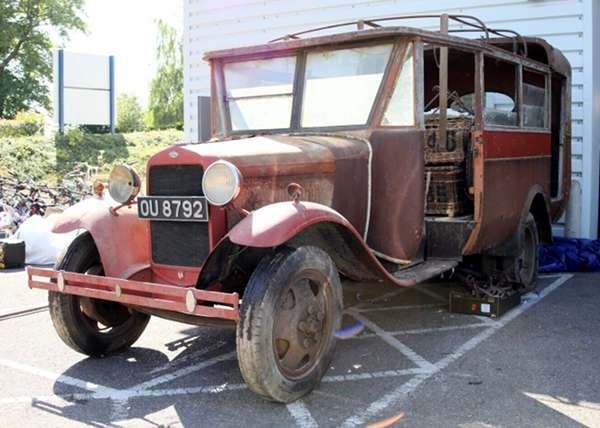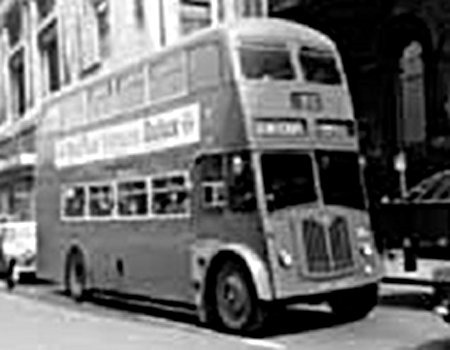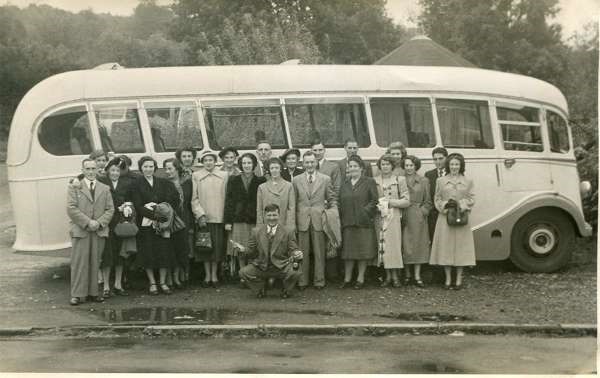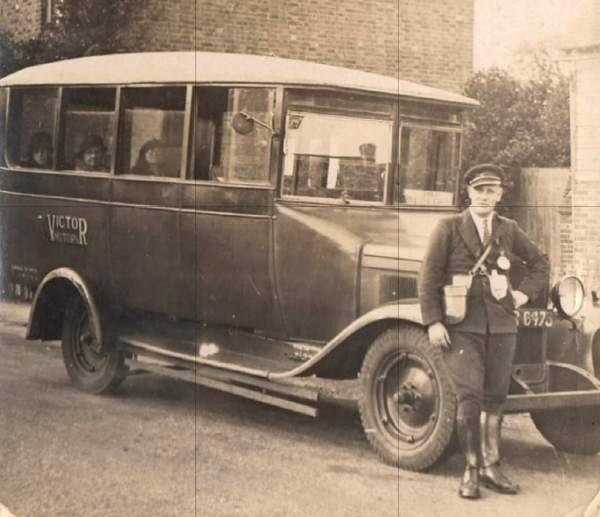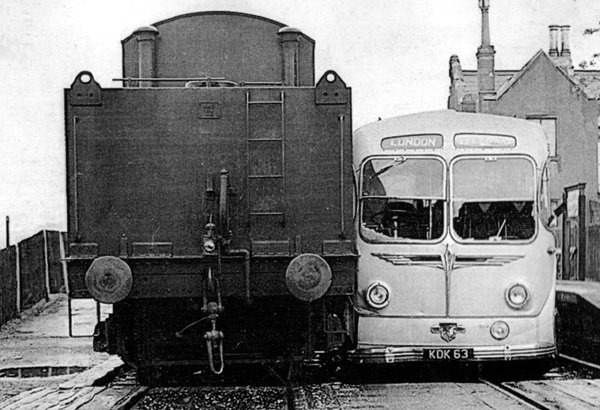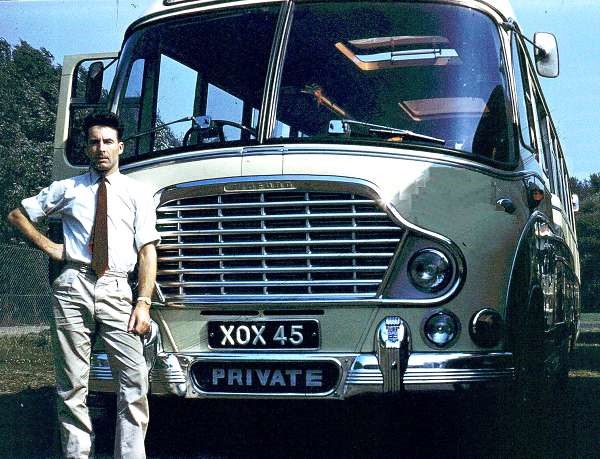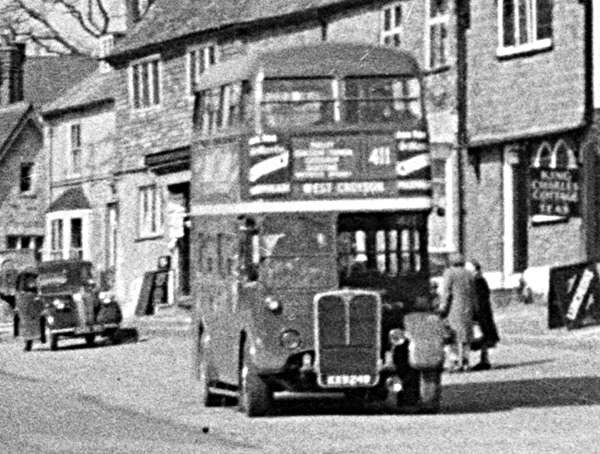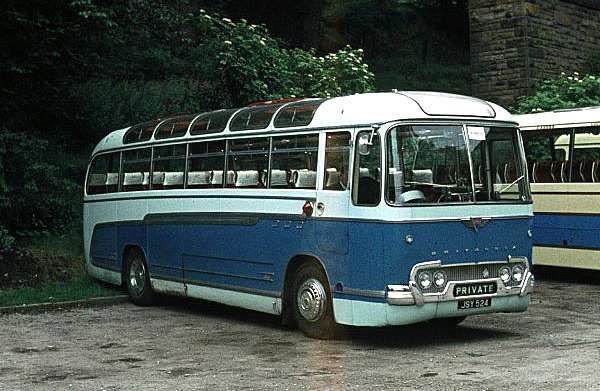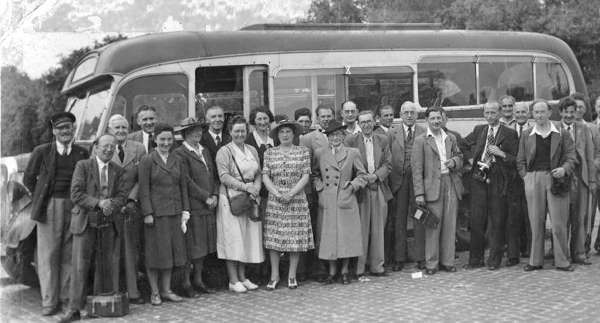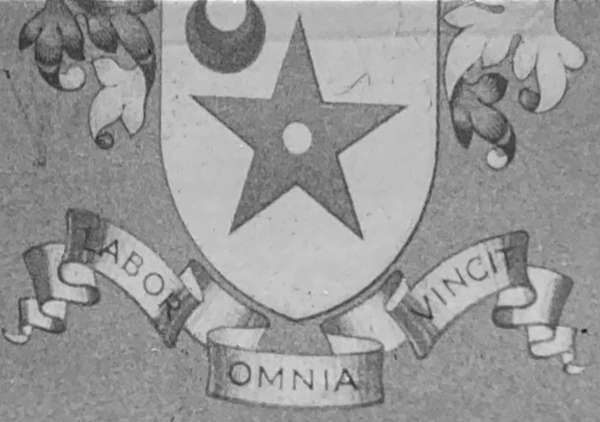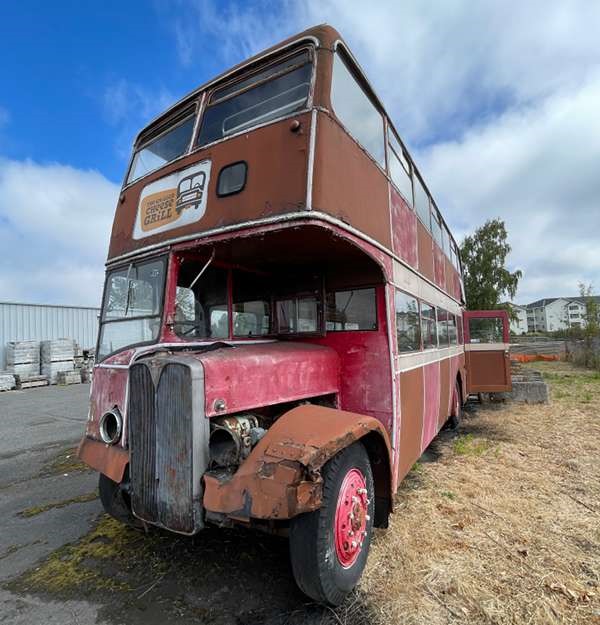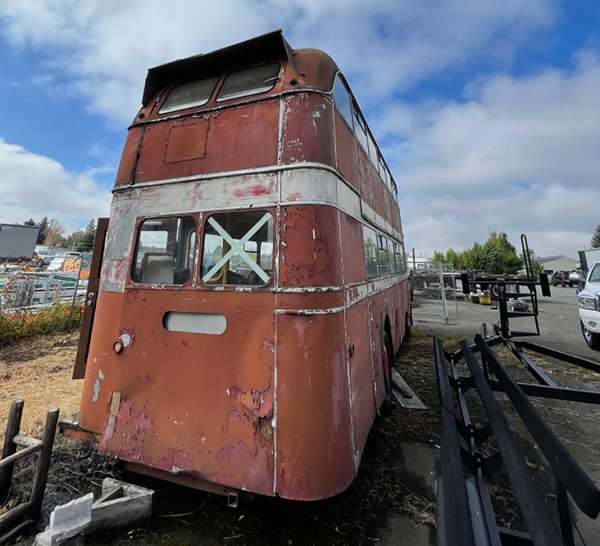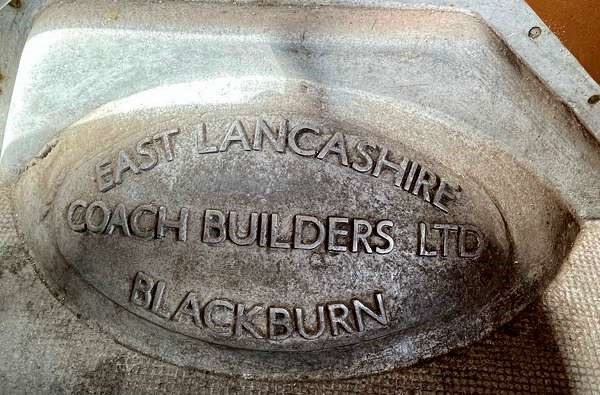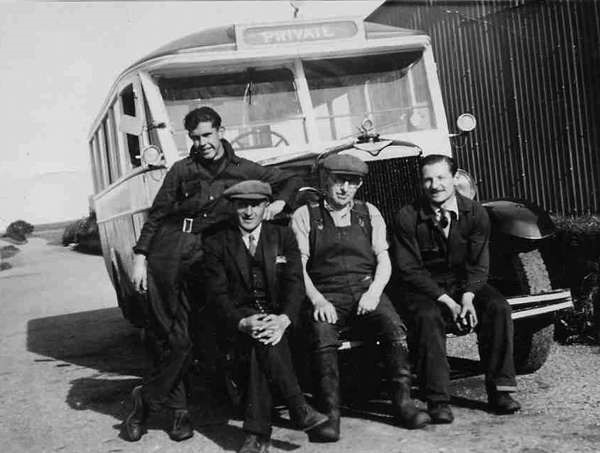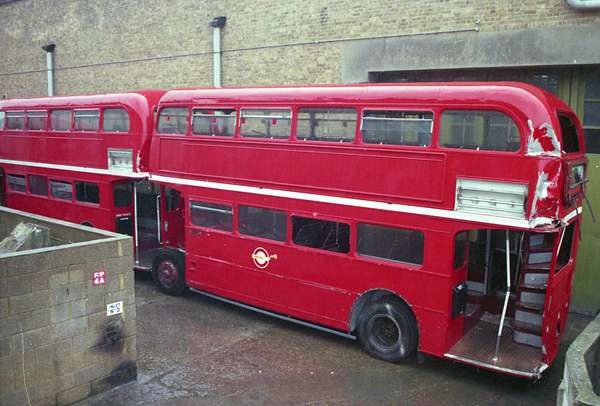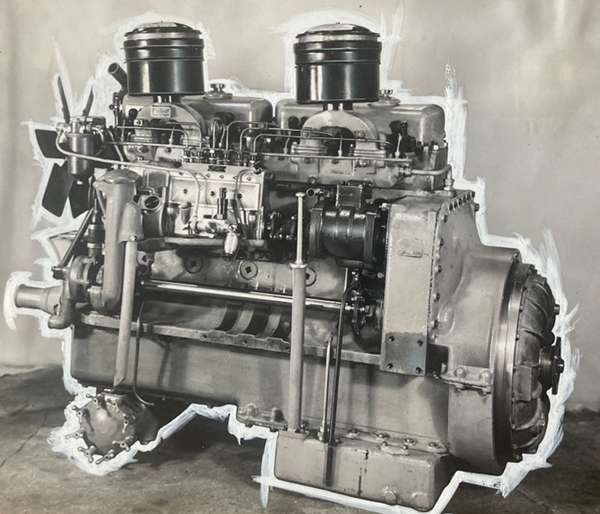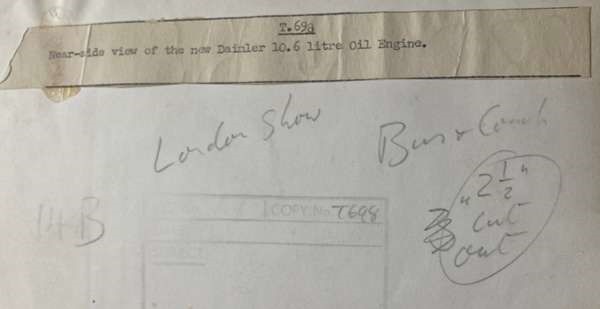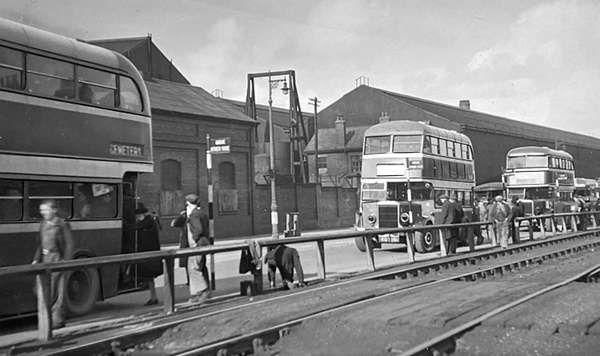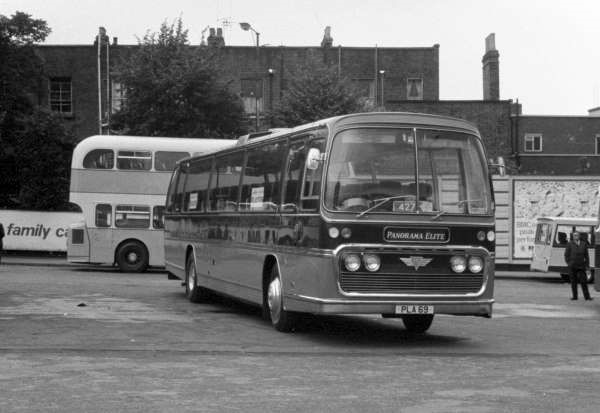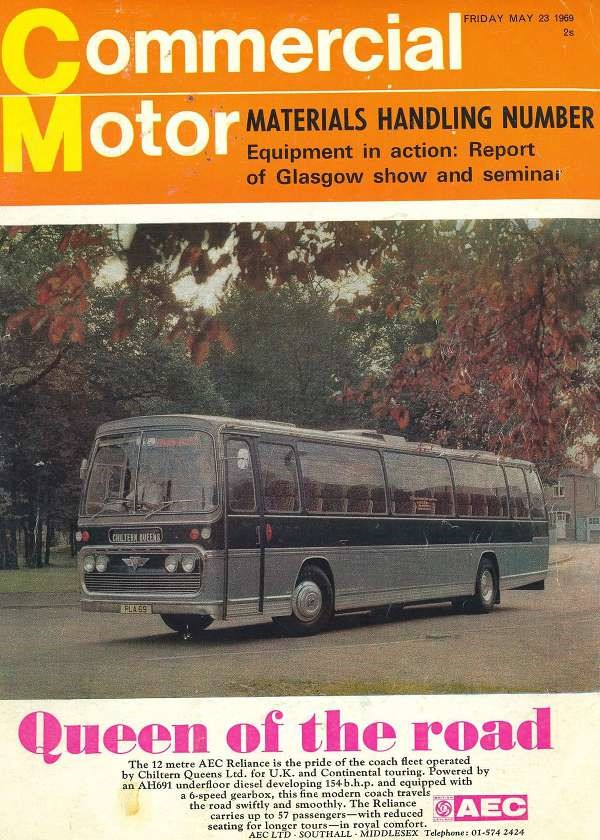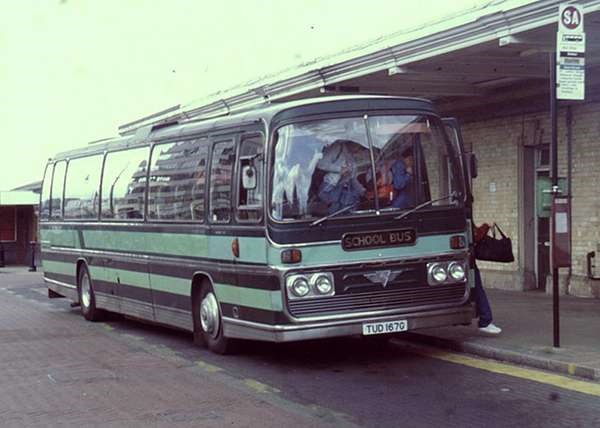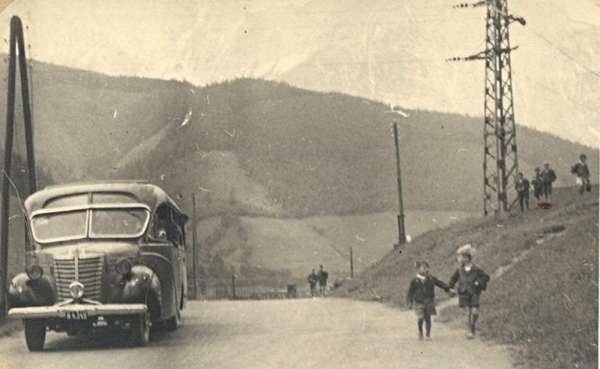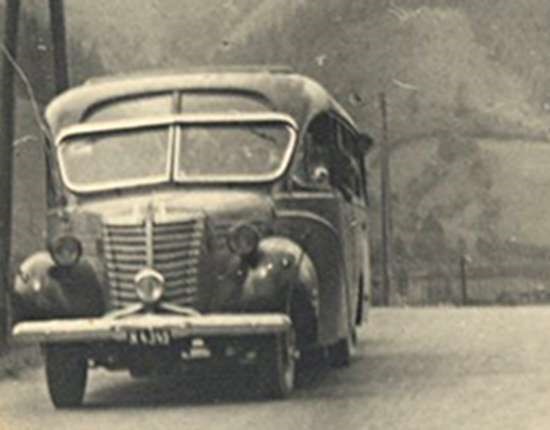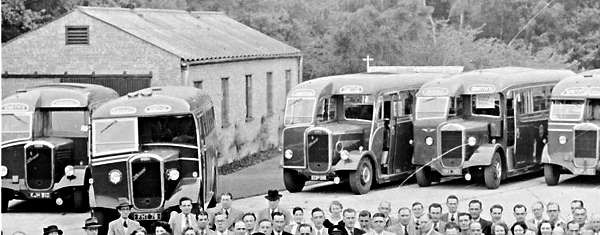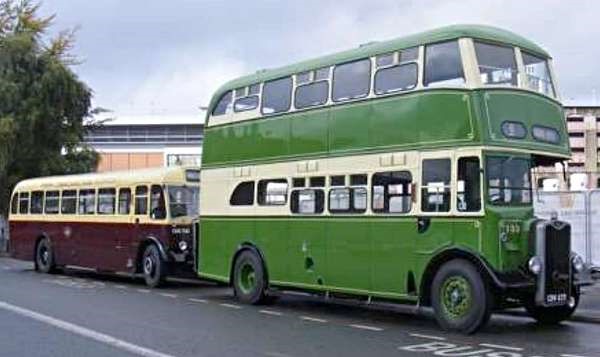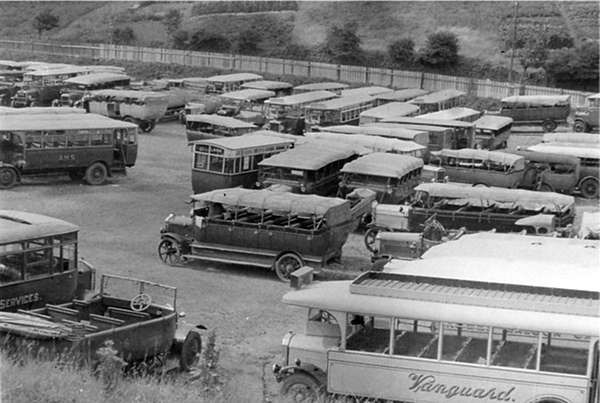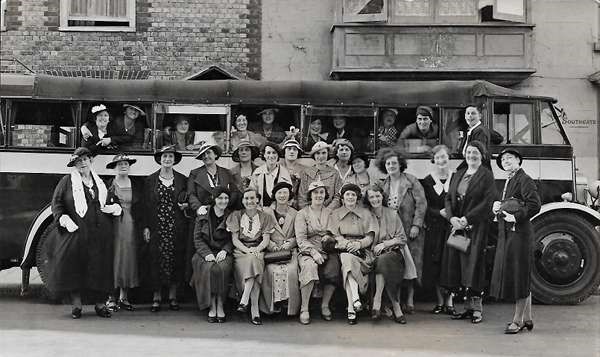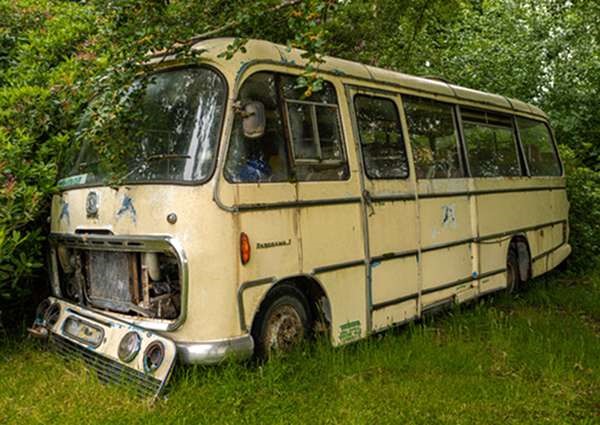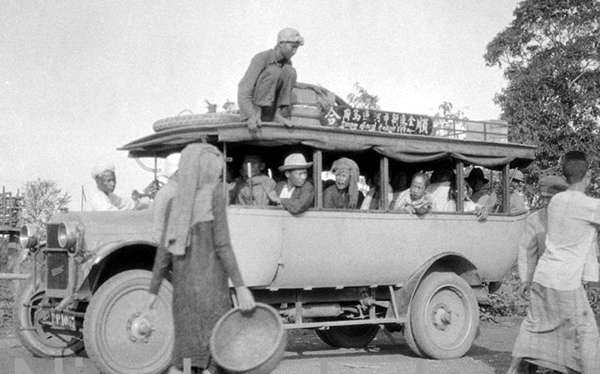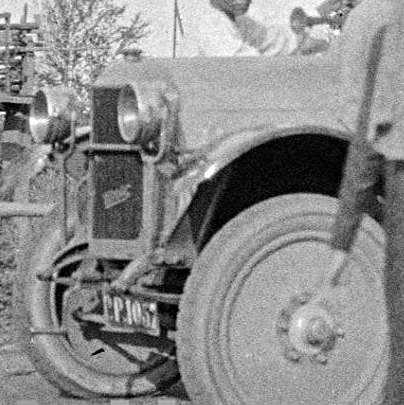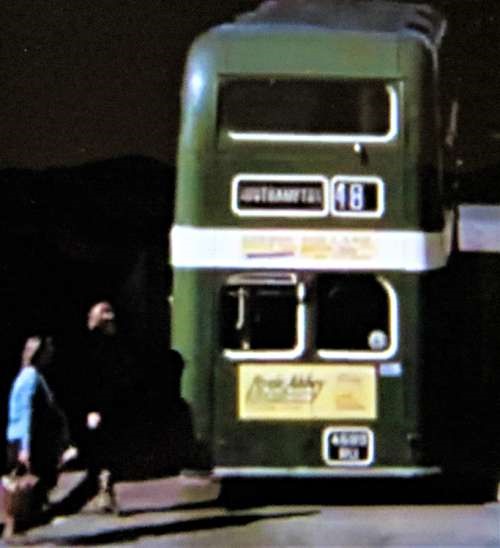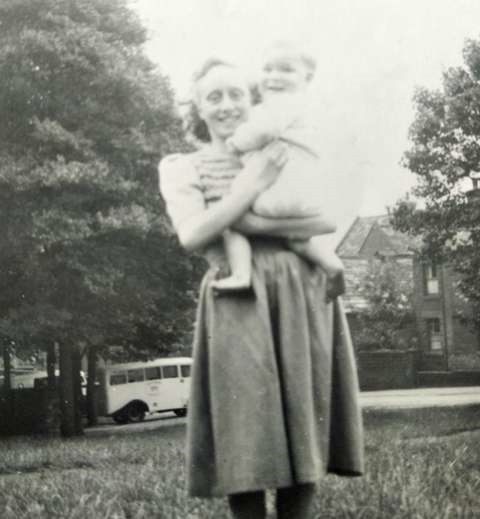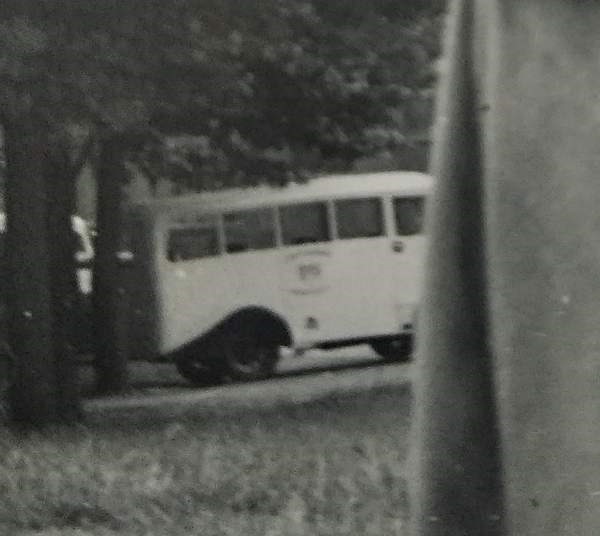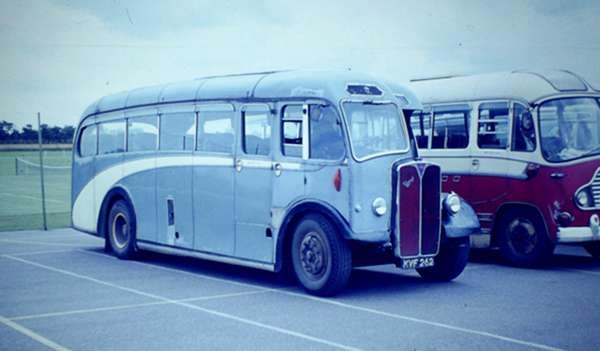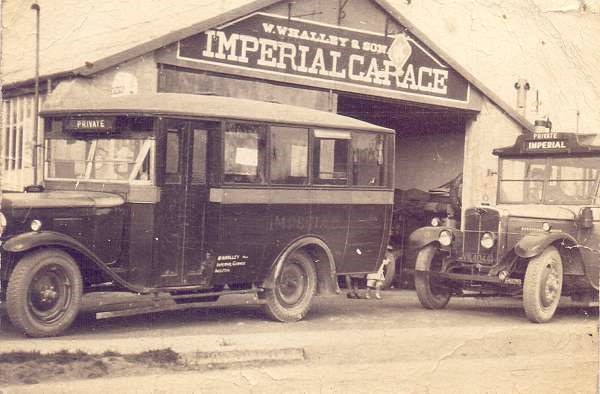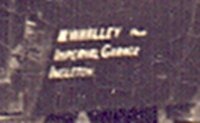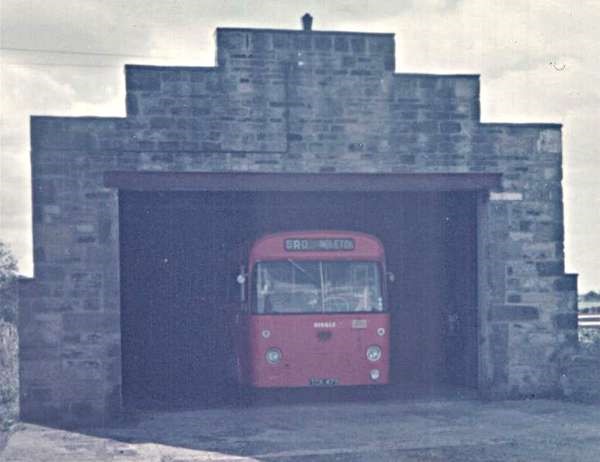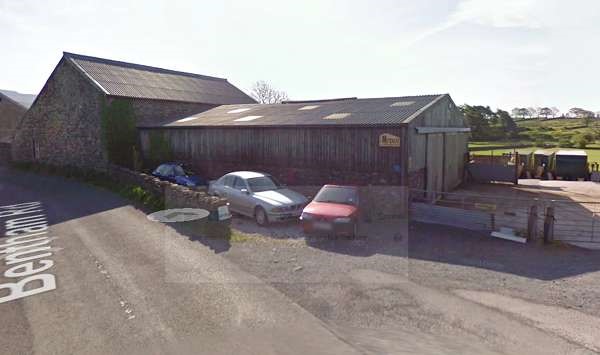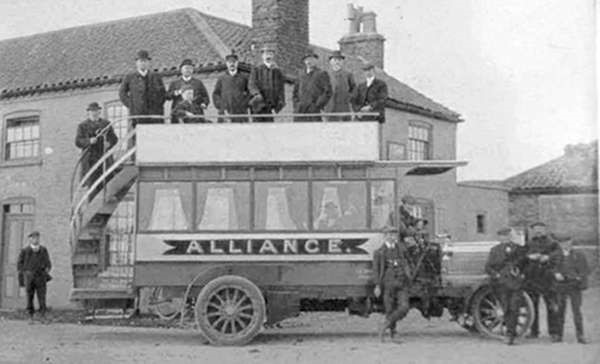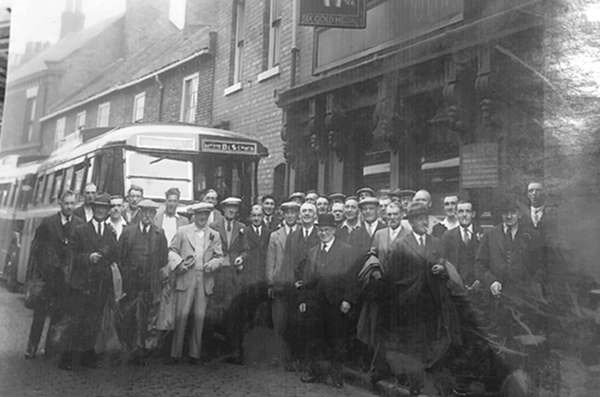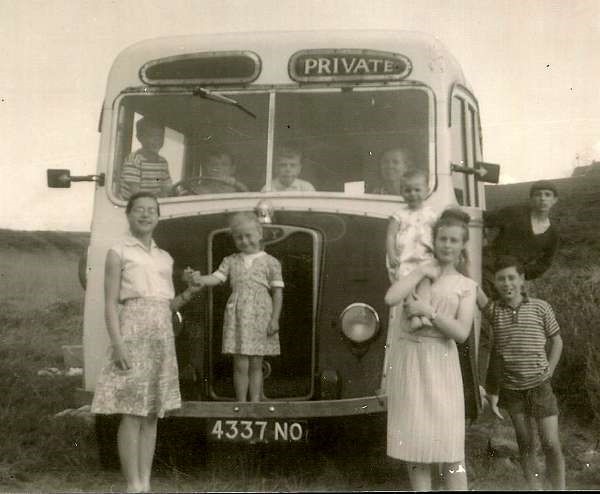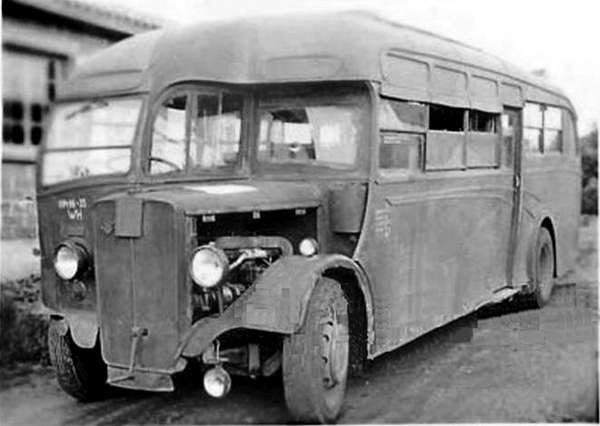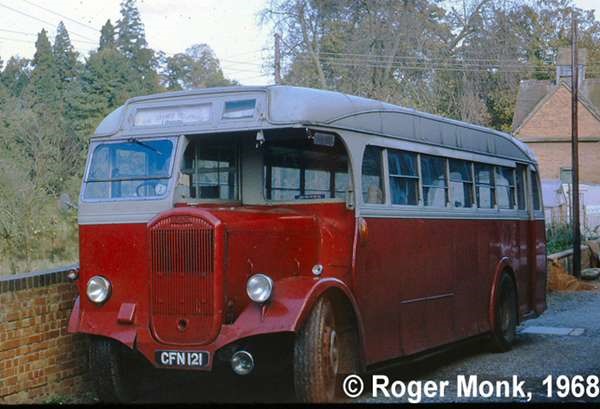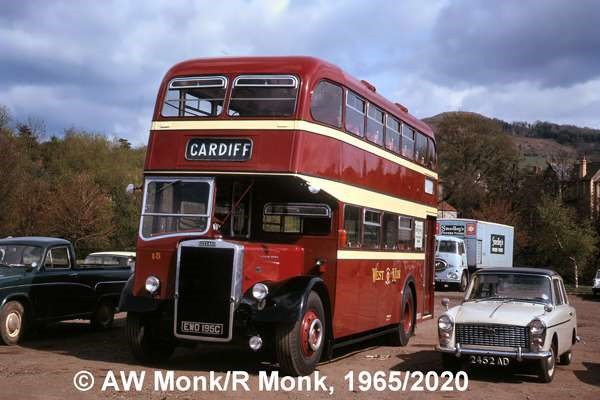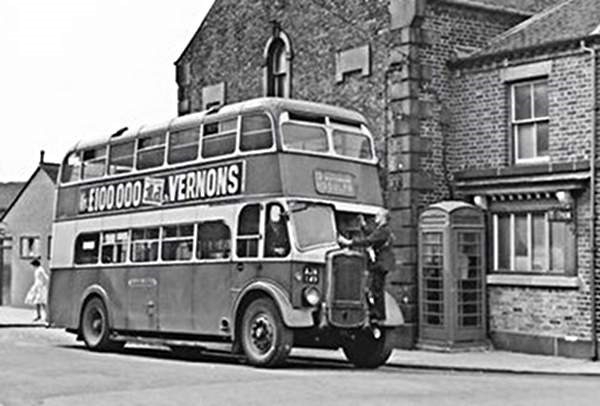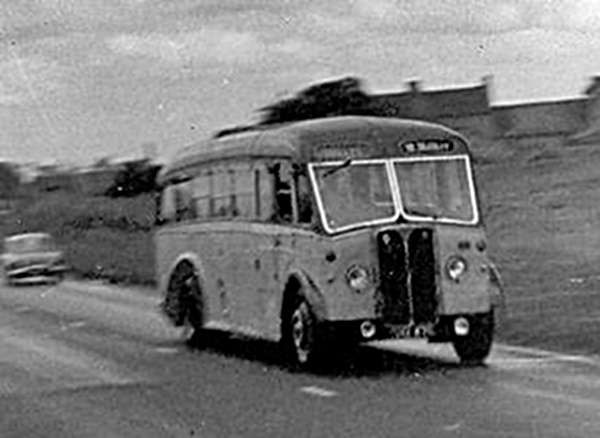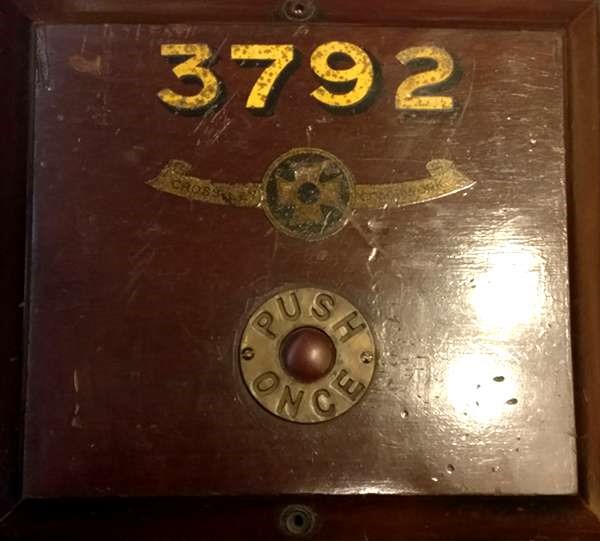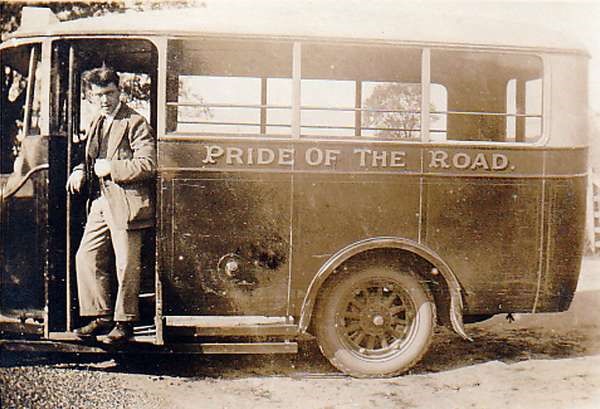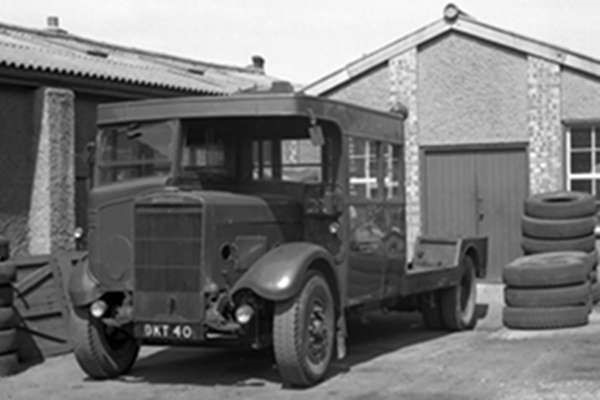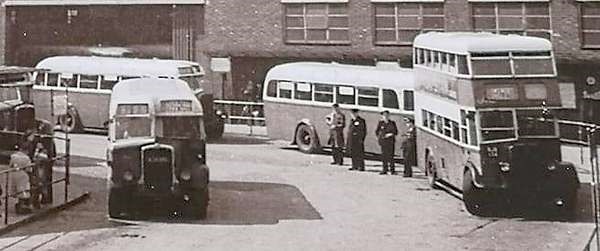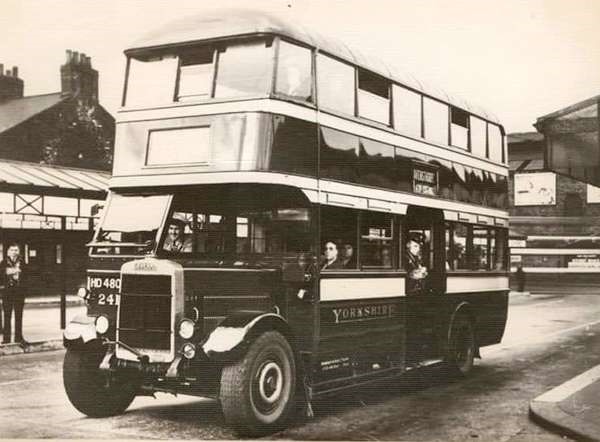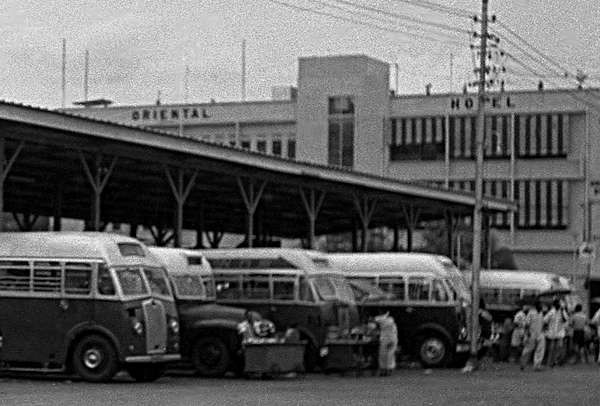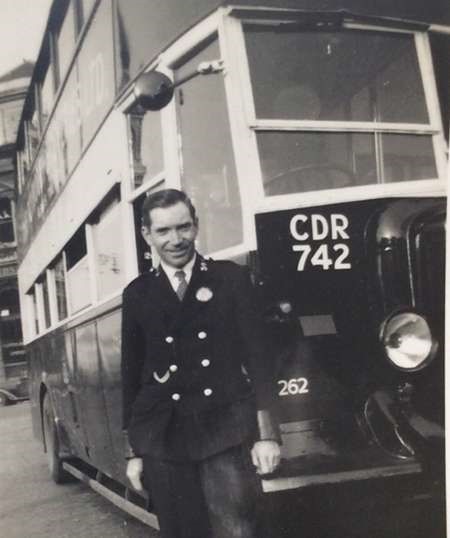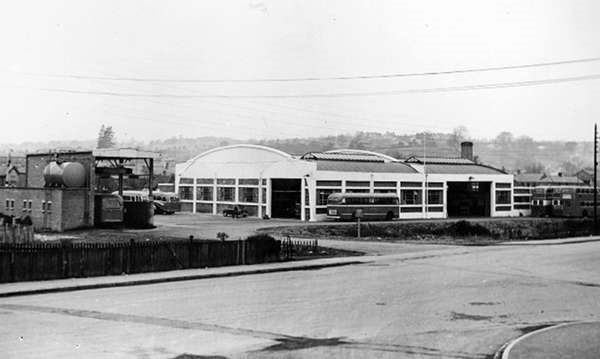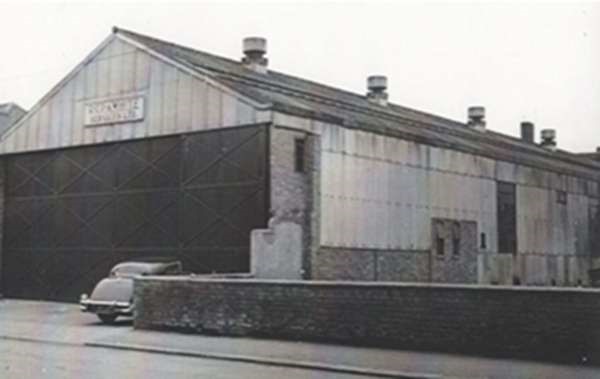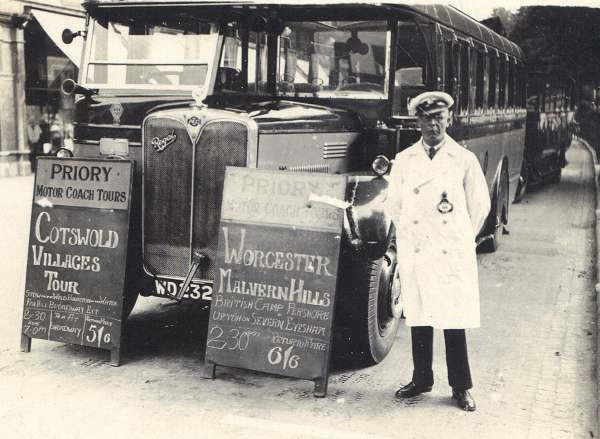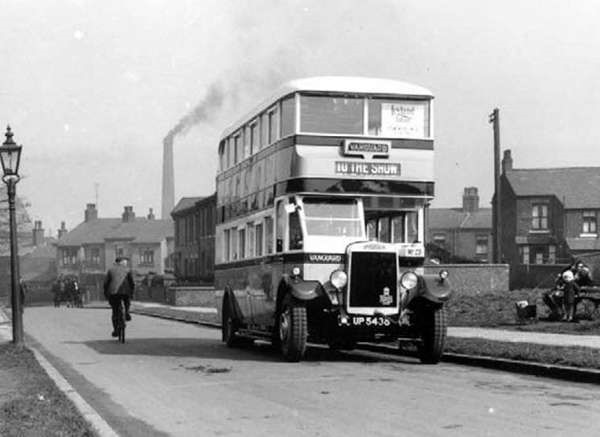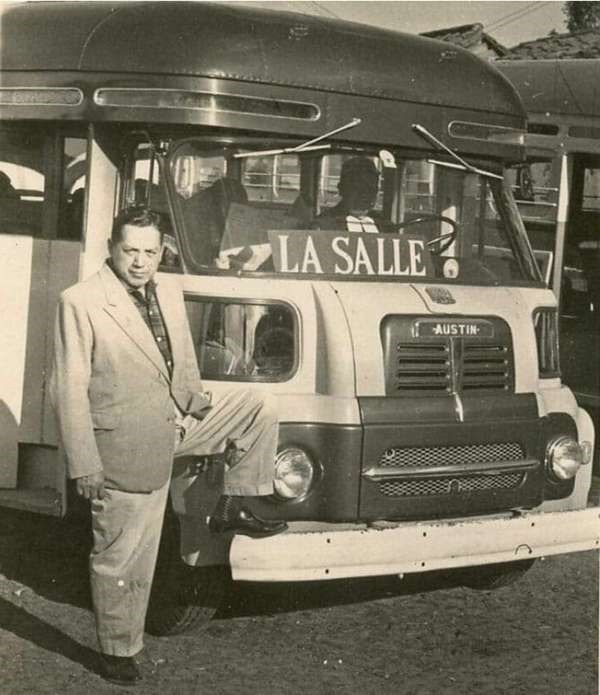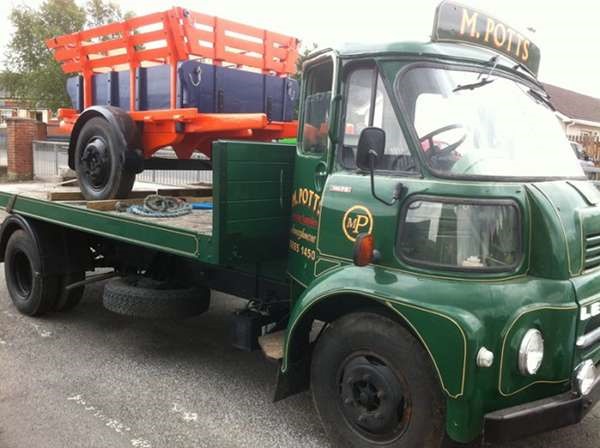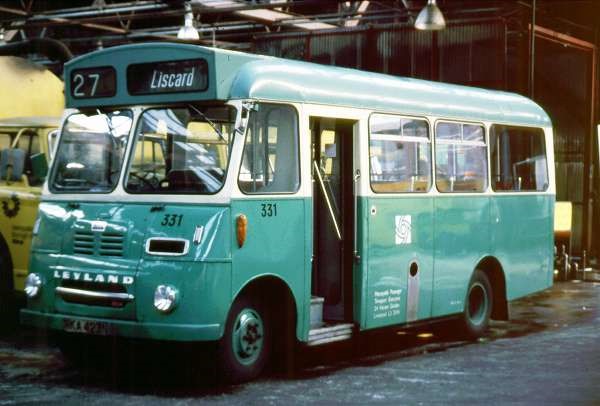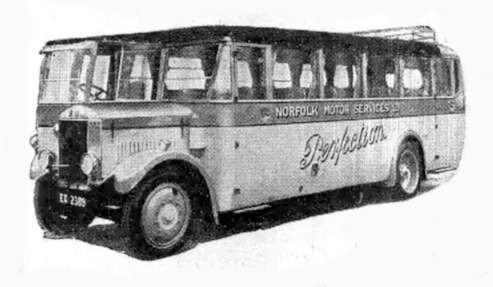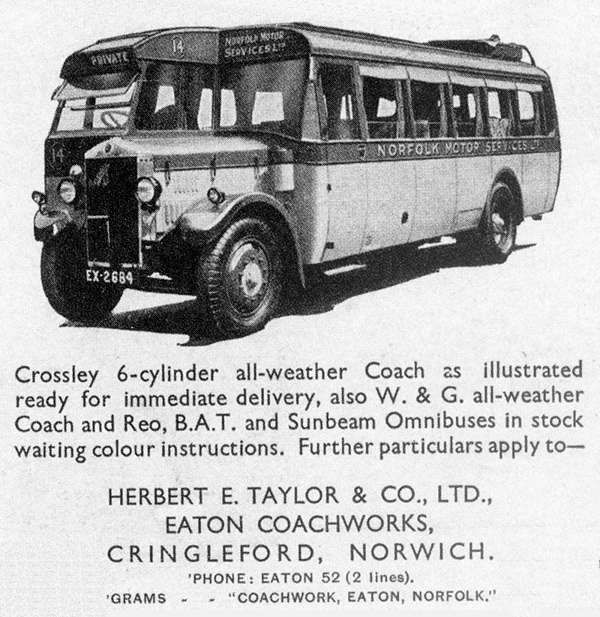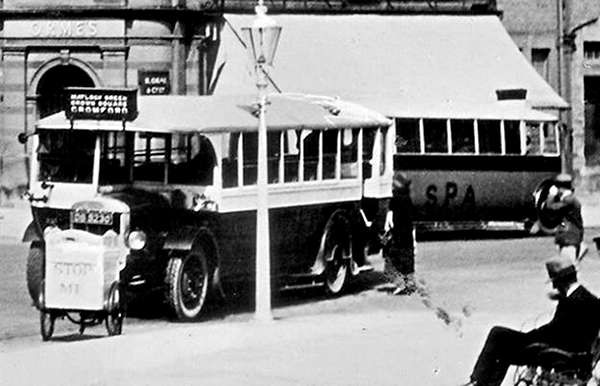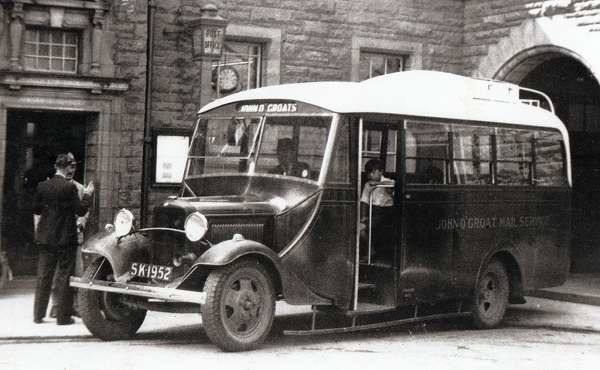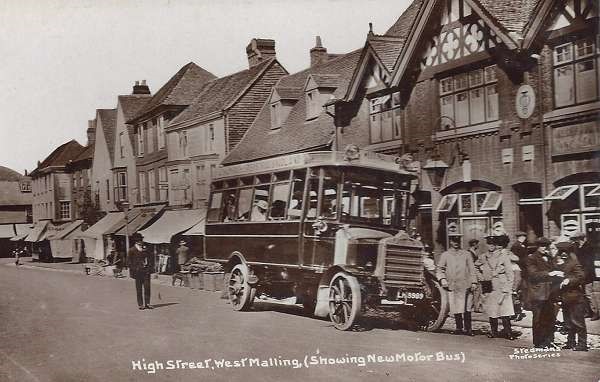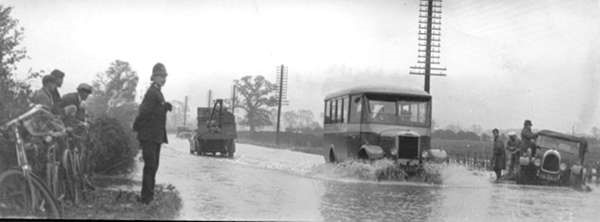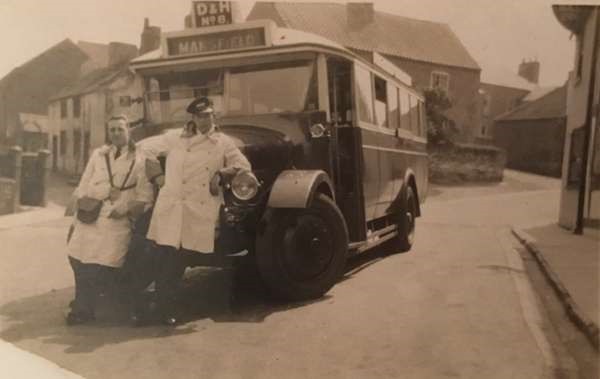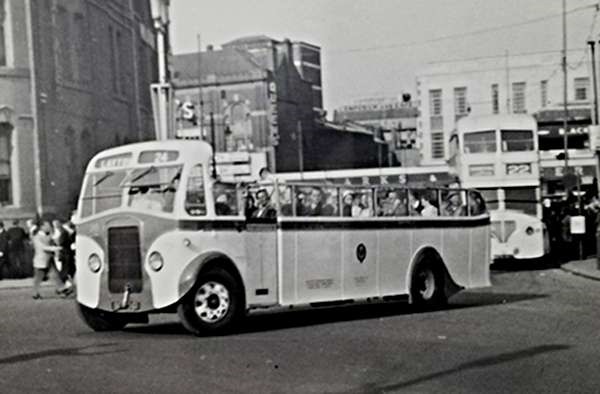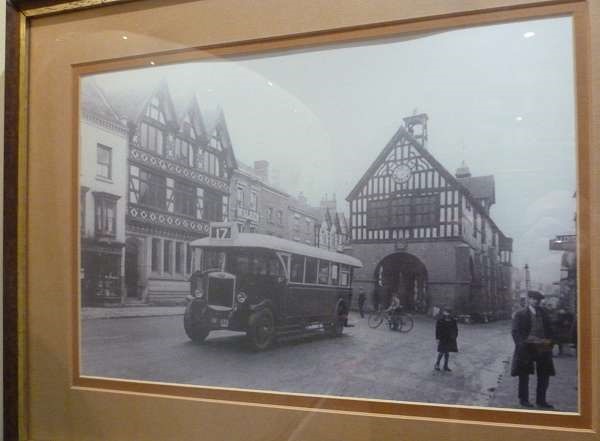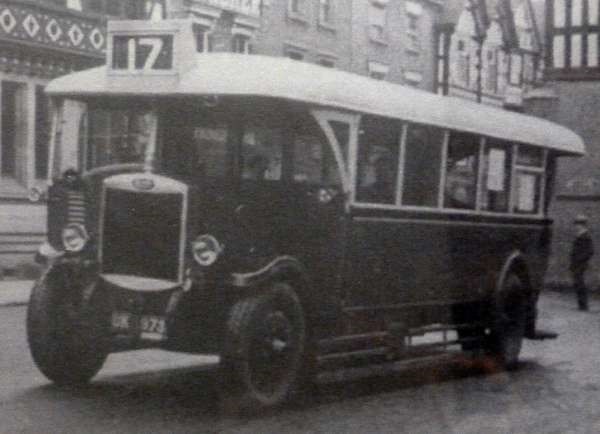Do you have a photo of a bus of which you have little or no information, or would you just like to know more about a particular shot. Upload it from the ‘Contact’ page or send it along as an attachment via email to
06/10/22
Ford AA OU 8792
This Ford AA looks to have been hidden away for many years (its not on PSV Circles preserved lists) Apparently it was new to A F Hassell of Liss in May 1931 they were a coal merchant and also ran a newsagents shop. Looks like they also ran the bus but maybe as a taxi as it apparently has a hackney carriage plate. Its currently for sale in an ‘as found’ condition by Andover, Marlborough & Winchester Auctions, of Andover. asking price is £20k which seems well OTT for whats on offer, a restored one would struggle to make that sort of money on a good day. Anyone know more of its history and/or A F Hassell.
John Wakefield
If you would like to comment on the above please click here
08/10/22 - 06:40
With 14 seats it would have been unlikely to be a taxi. Many PSVs new in 1931 Would have received local authority Hackney plates as the transfer of licencing to the Traffic Commissioners took place over the course of the year. The Excise Duty Classification "Hackney" for PSVs was used for many years after the requirement to carry plates.
David Hick
24/09/22
Liverpool Bus
What is this Liverpool bus?
John Hinchliffe
If you would like to comment on the above please click here
24/09/22 - 11:43
John,
This was L80 (NKD 680) a 1954 Leyland Titan PD2/20 with Alexander
bodywork. In 1959, L80-84 were rebuilt by Bond of Wythenshawe, or was it just the front end.
Only L80 received this grotesque sloping tin front complete with a thin rod connecting the bonnet to
the canopy at the extreme nearside corner to prevent sagging. Scrapped in 1971.
I remember it
well.
Details from Liverpool Buses by Paul Kelly.
Dave Farrier
03/09/22
Great Aunt Alice’s Mystery Coach
Can anybody identify the model of this coach and bodywork or operator.
Great Aunt Alice
(McIntosh) is stood directly behind the crouching driver (who has a bottle in each hand).
Her
husband, Albert is next to her with his coat over his arm. Albert was a coach trimmer, but for whom I
don’t know. They lived in Broadgreen, Liverpool and holidayed in Jersey, the Isle of Man, Scotland and
into Europe.
The coach has a cab door, traffic fingers, a severe front and separate headlights
and looks brand new.
There could be a half-cab coach visible through the rear end of the coach.
Over to the coach detectives.
Dave Farrier
If you would like to comment on the above please click here
04/09/22 - 06:46
This is surely a Mann Egerton FC31F bodied Austin K4/CXB of around 1949 vintage. John Carman’s comprehensive book on the Austin K Series Buses & Coaches lists one, KKF 100, being delivered new in November 1949 to a Liverpool operator, C Burnside trading as Priory Coaches. Could this be it?
Roger Cox
17/09/22 - 05:32
Roger,
Thank you for a fascinating reply.
I would not have
thought of an Austin/Mann Egerton combination in Liverpool. It may have been taken at Easter 1950,
judging by the coats, some three weeks before I was born.
Does anybody have any further
information on C. Burnside/Priory Coaches (Liverpool)?
Dave Farrier
Bus Routes through Whitchurch Hampshire.
I am trying to find out about the buses that were routed through Whitchurch, Hampshire. As I understand
it by 1928 Venture were running from Basingstoke to Andover via Whitchurch. They also ran from
Whitchurch to Newbury from 1929. King Alfred operated Winchester - Whitchurch - Basingstoke and offered
a connection to Venture to and from Newbury at Whitchurch. King Alfred were in Whitchurch (1925) before
Venture. It seems Venture garaged buses in Whitchurch. Venture were passed first to the Red & White
group in 1945, then on to Wilts & Dorset in 1950.
In 1977 Wilts & Dorset introduced local
branding for different parts of their network and revived the Venturebus name for the routes around
Basingstoke. In 1983 Venturebus was incorporated into Hampshire Bus, covering the operations in
Basingstoke, Winchester and Southampton with head office in Eastleigh. Hampshire Bus sold to National
Bus Company in April 1987. It was acquired by Stagecoach who run the 76 and 86 through the town today.
I have only found this one picture (from the Hampshire County Archive).
Any info regarding
the routes, the operators or buses and especially pictures would be welcomed.
Geoff Knappett
If you would like to comment on the above please click here
01/09/22 - 07:09
The map shows all of Venture’s routes as they were in 1949. The following
services ran through Whitchurch:
2 & 4 - Basingstoke-Whitchurch-Longparish(2) or Fox
Hill(4)-Andover
2A - Basingstoke to Overton (Limited Stop), one Saturday journey to
Basingstoke started in Whitchurch
4B - Whitchurch to Overton Mills (operated for Portals
Overton Paper Mills)
32 - Andover Junction to Whitchurch (joint with Hants & Dorset - see
below), most journeys just from Andover to Drayton Camp
35 - Newbury to Whitchurch (timetable
shows connecting King Alfred journeys to Winchester)
The 32 is an interesting one as it says
it’s joint with Hants & Dorset but my almost contemporary H & D timetable not only doesn’t show it
but doesn’t show any of their services in the area. I suspect it really meant Wilts & Dorset but I
only have a 1951 W & D timetable which includes all the Venture services as they had taken them over
by then, renumbered by the addition of 100.
David Beilby
19/08/22
Travel Agency Plaquette
You are the only site where I found infos about this company, Frames Tours Ltd. It’s just curiosity, as
I found in a river between Cortina and Dobbiaco (Italy) a metal plaquette 2,5 x 8,5cm with engraved.
Frames Tours Ltd.
245 Coventry Road
BIRMINGHAM Great Britain
Just asking
what can be an epoque, for what was. Found in a very touristic zone and also WW1 operations Theatre?
Sorry if off topic, sorry for my English and thanks in advance if you have any answer.
Napomoto
If you would like to comment on the above please click here
01/08/22
Salford Busses
As a kid visiting Salford in the 50’s/60’s I always wondered what that red round thing was between the
two top windows on Salford busses.
I did wonder if it was a Lancashire Rose or a bell and I would
really appreciate it if you or your members could tell me what it actually was.
The enclosed
photo is not mine by the way so the credit must go to the owner of the photo.
Stephen Crewe
If you would like to comment on the above please click here
01/08/22 - 15:23
A posting on the SCT’61 website by Geoff Kerr on 2 December 2013 reads:
The small red dome on the front upper saloon window pillar was Salford’s way of identifying an
8-foot wide bus. This was to help depot staff identify the bus width and set the bus washer
correctly - the wash operator must have been sitting in an elevated cabin. The practice would have
ceased when 7′ 6" wide buses disappeared, as no. 254 on the left does not have the dome.
Manchester City Transport identified 7′ 6" wide buses by painting the roofs grey,
whereas on 8′ buses they were red.
David Slater
02/08/22 - 05:37
How fascinating to discover these different ways of identifying width some 70
years ago and indeed the reasons for needing to!
The Tilling Group were more worried about
drivers and adopted white steering wheels for all 8′ wide vehicles. They reverted to black for
2.5m wide vehicles. From a driver’s point of view, it didn’t seem too much of a problem with front
engined vehicles because the extra 6 inch width was split 3 inches each side of the steering wheel
position. I found that when driving the likes of a Bristol LS, where the driver sits well to the
right and close to the offside of the vehicle, the tendency to put the nearside door pillar and
wheel into the rural verge was more difficult to counter!
Geoff Pullin
30/07/22
Oxted Station, Surrey
In connection with a model project, I’m urgently trying to find photographs taken around Oxted Station,
Surrey, in the 1940s, ‘50s and ‘60s. I’m looking for details of the buildings that surrounded the
station, rather than the buses themselves (although I am also a keen LT country bus fan). The only local
bus operator in that period was London Transport and the buses were mainly green. In particular, I would
like photographs of the small LT bus station which was located on the west side of the station and is
still in-situ today, although now used only as public conveniences. I’m happy to pay for copying, etc.
If you know of any possible sources of such images I’d be delighted to hear from you.
Brian Kidman
If you would like to comment on the above please click here
03/08/22 - 06:10
You may find this useful. https://www.flickr.com/
Nigel Edwards
25/07/22
Sheffield Location
I’m trying to find the location of this shot of Sheffield Transport Regal lV 214 taken in 1958. The destination blinds show route 31 to Walkley Lane, but the scene is from Sheffield’s industrial East End and definitely nowhere on the 31 route.
Michael Fawdry
If you would like to comment on the above please click here
26/07/22 - 06:00
The oblique tram track and the industrial buildings hint at it being the entrance to Tinsley tram depot. The bus seems to be about to enter Sheffield Road from Weedon Street.
Paul Haywood
11/07/22
Mystery Charabanc in Cambridge
Can anyone identify this charabanc that was seen on a pub outing at the Dog & Pheasant pub in Cambridge sometime in the 1920’s? Registration number looks like CE 6246 or CE 8246.
John Wakefield
If you would like to comment on the above please click here
13/07/22 - 06:10
CE 8246 was a Daimler Charabanc with 24 seats registered in March 1921 to
Brown Brothers trading as Lord Astor Coaches. However it had a 1914 chassis of unknown origin. It
passed to W. Cass of Great Waltham (Essex) in July 1927 and to an unknown dealer by May 1928.
Lord Astor Coaches were based at 68, Abbey Road, Cambridge.
Nigel Turner
15/07/22 - 06:11
Nigel’s identification of this vehicle enables some further details to be
gleaned from Paul Carter’s definitive volume, Cambridge 1. Lord Astor Coaches was, indeed, the
rather pretentious operating name of the Brown family of 68 Abbey Road, Cambridge. The first vehicle
was a Napier, CE 2108, initially known as the Cambridge Belle, that began operating excursions
shortly after WW1 from the town. (Cambridge didn’t become a city until 1951; the diocesan cathedral
city is Ely). This was followed by three Daimler charabancs in 1921, CE 8246, CE 8247 and CE 8675.
These were joined in 1922 by an ex WD Crossley 14 seater, and another Daimler, ER 1354, came in
1923. The standard Daimler chassis options of the period for single deck or double deck bodywork
were derived from the CC type designed before the war by Frank Searle, the London B type designer.
The power unit was the 5.7 litre four cylinder sleeve valve engine that gave 40 hp, though the RAC
rating, derived from the bore size, was 30hp. The chassis was variously known as the CC30 or the ‘40
hp’. Italian Lancia coaches took up the operations from 1928, so the picture must have been taken
between 1921 and 1928. Daimler built many chassis for the armed forces during 1914-18, and like
those of other manufacturers, these were reconditioned for civilian use after the conflict, which
would explain the 1914 origin of CE 8246, which probably applied to the others also. The picture of
a Daimler charabanc on this site is typical of the type, though bodywork styles varied considerably,
and many examples later acquired pneumatic tyres.
https://www.heritage-print.com/1922-daimler-charabanc-cirencester-19660711.html
Can we identify the wording of the notice being held by the gentleman
on the left of the group?
Roger Cox
Best I can get it I’m afraid.
17/07/22 - 06:35
Thanks Nigel & Roger for info. I would point out that the pub in question is
the Dog & Pheasant of Chesterton, there was another one in Newmarket Road Cambridge.
Here is
a link to another pic of a similar outing from the pub, the chara again looks like CE 8246 www.closedpubs.co.uk/cambridge_dogpheasant3.html
John Wakefield
17/04/22
Victor Motors
The photo is an old ‘mini bus’ with Victor Motors logo on the side. The driver is Mr. W.G.Burgess, my grandfather, who worked as a chauffeur/gardener for the Maud family of Broadford House, Horsmonden, Kent. He was born in 1898 and looks to be in his 30’s which may help to date the photo. I would appreciate any information on this vehicle if possible.
Lionel Burgess
If you would like to comment on the above please click here
18/04/22 - 06:31
It looks to me like a Chevrolet LQ (1929-31).
Pete Comb
19/04/22 - 06:14
"Victor Motors" was Tunbridge Wells Victor Motor Transport Company
Limited of Pembury Service Station, 127 Hastings Road, Pembury.
Founded in 1927 by Victor
C.L. Hayward and his brother George Henry Hayward, it ran services from Tunbridge Wells to
Hawkenbury, Horsmonden, Parsons Green, Pembury and elsewhere.
The services and thirteen
vehicles passed to the Maidstone & District Motor Services Limited (now renamed Arriva Kent & Surrey
Limited) on April 9th 1935. The brothers resolved to wind up their company on June 12th 1935
although their garage business appears to have continued for a few years after that.
Unfortunately I don’t have a copy of the M & D fleet history published about 45 years ago but that
would probably give details of the Victor fleet.
I think we are safe in saying that the photo
was taken between 1927 and 1935. This would tie in with Wilfred George Burgess’ birth date of 1898.
Nigel Turner
19/04/22 - 16:26
According to the Maidstone & District Fleet History published by the M & D and East Kent Bus Club, KR 6473, which this would appear to be, was a Chevrolet U with a B14F body of unknown manufacture, which was new in August 1930. It passed to Maidstone & District on 9th May 1935 but was not operated.
John Kaye
22/02/22
Isle Coaches of Owston Ferry
I am researching the fleet of Isle Coaches of Owston Ferry and came across a Commer bus BSG 915 acquired from Sellars of Sheffield in 1950. Does anyone know anything about this vehicle. I believe it is an Edinburgh registration, so would have been second hand to Sellars. It was sold to Isle Coaches through Hopkinsons Motor Auctions of Conisborough.
Christopher Proctor
If you would like to comment on the above please click here
23/02/22 - 05:55
PSV Circle book C1000 shows BSG 915 as new to Cruickshank, Edinburgh in 05/1938 with a Waveney C20F body. The chassis number is shown as 46F900 but is marked as ‘unconfirmed’. Any help?
Les Dickinson
10/02/22
Yelloway Motor Services - 1950’s Accident
I have been trying to find out info about the accident at Lamport Station level crossing in
Northamptonshire involving 1953 Leyland Royal Tiger/Burlingham Seagull KDK 63 sometime in the 1950’s in
which the coach was spectacularly ‘shunted’ by a loco to end up alongside the station platform!
The picture was in a Facebook post and despite me enquiring no-one responded.
There is no info
either in the usually comprehensive Railway Archives-Accidents site.
If the coach was the
southbound Lancashire to London service, as per destination blind, then it would have passed Lamport
(about halfway between Market Harborough and Northampton about 4.20pm on the day service, or at 4.20
a.m. on the overnight service those times taken from the 1953 summer abc Coach Guide to get an
approximate idea of the time.
Over to You knowledgeable people. Anyone?
David J Smith
If you would like to comment on the above please click here
David Slater
11/02/22 - 05:50
During my time at Yelloway (1967-1974) this accident came up in conversation
from time to time.
From what I recall the story was that the coach was operating the
southbound overnight service down to London.
The roadway from Maidwell to where Lamport
Station was (Hoppin Hill) is a downward slope to a hollow. It was apparently misty in the early
hours and the coach somehow hit the railway crossing gate bouncing off it and coming to rest between
the locomotive and the platform.
I have a copy of the photograph which may have a date on it.
I will have a look for it.
The coach was subsequently repaired and returned to service.
David Slater
12/02/22 - 05:24
The copy of this photograph I have is actually a cutting from the Rochdale Observer dated Saturday 2 June 2001.
The caption to the photograph reads:-
"It was 4:30am on a foggy morning in July 1957 when the coach, KDK
63, demolished level crossing gates at Lamport on the Northampton-Market Harborough line. The
engine WD 2-8-0 No 90103, running light engine to Nottingham, struck the coach, swinging it
round and squashing it between the platforms."
David Slater
15/02/22 - 05:45
Thanks for your welcome replies David.
That must have been quite a
shock for the driver and any passengers! Do you know if there were any casualties?
With the
reputation of those Royal Tiger PSU 1/15 chassis with their vacuum brakes and their marginal
stopping ability it does make one wonder if that was a contributing factor to the
accident….
David J. Smith
XOX 45 Can it Really Still Exist?
This is a long shot but it would gladden my old frame if I could still see it - IF it really does still
exist. This is really an appeal to all you great experts, who I greatly admire, with your boundless
knowledge base!
It would appear the DVLA check reveals "it" is taxed until Sept 22 as A
"Bedford 1959" which seems to indicate the Reg No has not been acquired by a lesser vehicle.
I attach the photo as a vehicle identifier - ignore the Driver (me) with hair . . . . . .
Nigel Edwards
If you would like to comment on the above please click here
27/01/22 - 05:43
According to this website:-
https://vehicleenquiry.service.gov.uk/VehicleFound?locale=en
XOX 45 is
currently taxed, renewal due September 2022. It is described as a 1959 Bedford with a petrol engine,
vehicle colour blue.
A search on Google reveals just a couple of photos, both clearly old
(one is dated 1970), so presumably not in active preservation.
Nigel Frampton
31/01/22 - 06:14
The last PSVC record of it is that it was sold at auction 9/82 ex Crewe Health Authority. Looks like there is some jiggery-pokery going on to keep the number alive. Not sure how its been taxed as ASKMID shows it untaxed.
John Wakefield
04/02/22 - 05:38
Thanks Nigel & John, It is all still a mystery but good to know it seems to have had an ‘afterlife’.
Nigel Edwards
12/12/21
411 bus 1951
I wondered if you could help me. I am doing some research for a local non profit history book. I have a 1951 photo of a double decker 411 (RT?) in Bletchingley Surrey on route to West Croydon. I want to colourise the picture but I don’t know if it was a green bus. I have done some research online but have not come up with answer.
David McCleave
If you would like to comment on the above please click here
13/12/21 - 06:32
Yes, the RT shown is one in the Country Area green livery. The 411 route was operated by Godstone garage and ran from West Croydon to Reigate via Old Coulsdon, Caterham, Godstone, Bletchingley and Redhill. From West Croydon to Godstone it ran common with the 409 that continued to East Grinstead and Forest Row. Between Godstone and Reigate it was common with the 410 which met up from Bromley, Biggin Hill, Westerham and Oxted. In 1951 the 409 and 411 routes were RT operated, but the 410 ran with the lowbridge RLH Regents which had been diverted from a Midland General order in 1950 to replace the elderly "Godstone STLs" of 1934. The picture of the bus is a little indistinct, but the registration appears to be KXW 249, which is that of RT 3140. This went into service at Godstone from new in May 1950 and stayed there until the end of 1953. After overhaul at Aldenham it was then transferred to Leatherhead garage. In the course of its subsequent life it passed through several other CB&C South Division garages including Dorking, Swanley and Dunton Green before being sold in 1971. I acknowledge the remarkable Ian’s Bus Stop site for expanding my own records and recollections.
Roger Cox
14/12/21 - 06:15
As an aside, the car in the background is a Standard 8hp, made from 1945 to 1953.
Chris Hebbron
29/11/21
‘Britannia’ body styled JSY 524
What I am missing is the name of the operator at the time the picture was taken. BLOTW shows that it
was new to Allan’s Coaches, Gorebridge, Midlothian in 1961.
The view was taken in Buxton on June
21st 1970, and I failed to record ownership at the time. The label in the windscreen could possibly be a
clue, as it reads ‘On hire to W Martin (then illegible)’.
Personally, I always felt that
the Britannia was one of the more attractive body styles of the period. All the elements seem to belong
to each other, and it is not overloaded with chrome.
Alan Murray-Rust
If you would like to comment on the above please click here
01/12/21 - 07:16
Walter Martin was a friend of mine and a small operator in Sheffield. In his
turn, he was a friend of Cyril Littlewood and Wilf Anderson, all three sharing Littlewood’s garage
off Petre Street in Sheffield. At the timme of the photograph, Walter ran three Bedford VAMs (1 x
VAM14, 2 x VAM70). I would have expected to recognise this coach, but I don’t.
Walter died
and his son John continued to run the company along with his mother, the indomitable June. Since my
parents’ deaths, my links with "home" have become more tenuous. I suspect, but do not know
for sure, that Martin’s coaches is no more - although Anderson’s continues with his daughter and
son-in-law as Bonnet.
David Oldfield
02/12/21 - 06:50
Maybe Martins of Middlewich who were also a Dealer.
Tim Presley
03/12/21 - 06:01
I stand corrected. Wilf’s daughter and son-in-law ran their own operation whilst he was alive. Since his death, they have renamed their operation Anderson Coaches, Rotherham.
David Oldfield
15/11/21
C. J Cook of Biggleswade, Bedfordshire.
I am on the look out for images of buses and coaches with the fleet of C. J. Cook of Biggleswade,
Bedfordshire. (traded as Kumfy Cabs & Coaches and later C.J Cook or Cook’s Coaches).
In
particular I am trying to identify the coach in this picture; which I believe to be a Dennis. The PSVC
records Cook as having three Dennis single deckers. DZ 1812 a Dennis Ace "Flying Pig" and then
DXL 609 and DXF 587 which are recorded as Dennis Lancet IIs. However this is a normal control and
therefore I don’t believe it to be a Lancet II. Could anybody shed any light on the bodybuilder or if
these registrations are correct?
John Hammond
If you would like to comment on the above please click here
16/11/21 - 06:04
From the meagre view of the radiator, it looks to me like a Dennis Falcon II, from the 1950s.
Chris Hebbron
16/11/21 - 06:05
Its HHK 852 a Dodge SBF with Thurgood C26F body new to Benjamin, Grays 3/39
John Wakefield
02/11/21
Austin KAC 991 and MNX 867
Mystery has surrounded the bodywork and chassis of KAC 991. It certainly is not a standard Austin K8. I
have seen listed recently the coach builder was Allbodies of Cardiff, I can find no information on this
company.
Does any one have a picture of MNX 867
David Aston
If you would like to comment on the above please click here
20/11/21 - 06:19
In ‘Commercial Motor’ dated 10/6/60 Allbodies Ltd are named in a list of
‘some ambulance builders’. Their address is given as Dumballs Road, which is in the Butetown
district of Cardiff. In CM for 9/4/54 they are reported to have constructed a ‘mobile
laboratory for road materials’. Their address is then quoted as Hodges Row, which is also in
Butetown, only a stone’s throw from Dumballs Road.
From 25/1/95 to 6/9/11 there was a company
entitled S H Allbodies Ltd, address Cathedral Road, Pontcanna, Cardiff, this may or may not be a
continuation of the same company.
You will be aware of the photo of KAC991 on the Classic Bus
Website, in view of the fact that MNX867 was from the same source and built only two years later it
seems likely that it would have looked much the same. The fact that KAC991 is recorded as coach
seated, but MNX867 bus seated, may be differing appraisals of the same thing.
David Call
26/10/21
Bus Corporation Emblem
Could anyone identify this emblem on the side of an old bus please.
Ralph Sheridan
If you would like to comment on the above please click here
27/10/21 - 05:53
The coat of arms is from Ashton-under-Lyne. As it’s very local I’m a bit
embarrassed that I had to look it up, but one of the problems is that the motto is a popular one,
also used by Bradford at least.
It can be seen here, for example: https://davidbeilby.zenfolio.com/
Not just on the bus but also as the
watermark, which does rather heighten the embarrassment!
David Beilby
27/10/21 - 05:54
The emblem is that of Ashton-under-Lyne as in the link below www.sct61.org.uk/gallery/badges/ahc0a
John Kaye
27/10/21 - 05:55
Ashton-under-Lyne
Phil Blinkhorn
27/10/21 - 05:56
The Latin motto "Labor Omnia Vincit" = work conquers all (which sounds remarkably akin to the infamous "Arbeit macht frei") was/is the motto of Ashton under Lyne, West Bromwich and Bradford. But a quick internet search reveals no similarity of any of their emblems to this one.
Stephen Ford
27/10/21 - 05:58
Ralph, the coat of arms is that of Ashton under Lyne. At first the motto threw me as Labor Omnia Vincit ("Work Conquers All") is also the motto of Bradford, although the coat of arms is totally different. Please see links for details (hope they work!):- www.sct61.org.uk/gallery/badges/bfc0a & www.sct61.org.uk/gallery/badges/ahc0a
Brendan Smith
27/10/21 - 05:59
I believe this to be the coat of arms for Ashton-under-Lyne. You can see an image and read about it here: https://www.tameside.gov.uk/Towns/Ashton-under-Lyne-Menu#coat
David Allen
27/10/21 - 06:01
Ashton-under-Lyne Corporation Transport.
Pete Comb
01/11/21 - 07:01
Thank you very much for your help.
Ralph Sheridan
25/09/21
Mystery East Lancs Regent III
I’m trying to learn more about the history of this bus I recently bought.
Whit Scott
If you would like to comment on the above please click here
27/09/21 - 05:35
I think it is ex Huddersfield Corporation built in the mid 1950s
Geeoff Simpson
27/09/21 - 05:38
This is clearly a former Huddersfield Joint Omnibus Committee AEC Regent III
9613E with East Lancs. H33/28R body, new in 1955. There were, back in the 1970s, three of these
preserved - 178, 179 and 181 (JVH 378, 379 and 381). 178 much later found itself owned by the
Sowerby Bridge-based vehicle recovery and HGV maintenance company Stoneywood Motors, who fully
restored and rallied it for a while and though I believe they later sold it on I wouldn’t have
thought it would have deteriorated to the extent that the one in this photo suggests. 179 was
believed to have been scrapped long ago. 181 was in the Mersey & Calder Bus Preservation Group
collection, owned by Graham Mitchell, who rallied it extensively during the 1970s.
However,
following an arson attack at the yard in Halifax where it was stored it was extensively damaged
around its rear end, being parked next to the target of the attack - a Morecambe & Heysham Regent
III which was totally gutted. Graham subsequently parted with 181 and it languished at various
locations still in its fire damaged state, at one point turning up at Tony Blackman’s Halifax Joint
Committee premises, but then it was reported to have moved south where it was advertised for sale.
The bus in the photo appears to have had been used for catering purposes and has had a door
added and some sort of cowl over the upper saloon rear emergency window. The thing that puzzles me
is that the front nearside bulkhead window is not as they were originally, being a rather crude
looking small rectangular affair, rather than the typically East Lancs. type with curved lower edge.
I would suggest this is most likely 181. 181’s chassis number was 9613E4312 and the East
Lancs. body number was 5110. Maybe there are still chassis or body plates somewhere confirming these
details.
John Stringer
02/10/21 - 05:19
John S, it’s one of the lowbridge East Lancs Regent IIIs. The give away being
the stepped down rain channel on the o/s between decks. That makes it 226-231, GCX 26-31 new in
1952, or 232-239, HVH 232-239 (1954) or 240-243, JVH 370-373 (1955).
Whit, are you based in
the USA by any chance? If so perhaps we can pin it down and take it from there.
Eric Bawden
03/10/21 - 05:35
In narrowing down which bus it is, we can rule out the earlier batch 226-231 as they didn’t have the flush-mounted windows seen on the mystery bus. With 234 and 243 already accounted for (still extant in this country) the identity is getting closer as it is one of 232/33/35-42.
David Beilby
03/10/21 - 17:27
On looking closer I can see now that it is, as Eric rightly points out, one of the lowbridge ones. It was the wide angle view that fooled me, making it look taller than it really is.
John Stringer
04/10/21 - 06:15
If it is in North America I seem to think about three or four of the later
Huddersfield Lowbridge Regent III’s were exported there in about 1974-ish.
One of them was
1955 Regent III 240, JVH 270, in a similarly derelict state to our mystery bus but it’s not 240 as
there is a photo somewhere on the internet of it in, I think, California and the front cab and
radiator assemble appear to have been pushed back, either by accident or the result of a rough
shunt.
Eric Bawden
17/09/21
Cummings Bus
Can anyone identify the bus make in this photo taken in 1930s at Cummings Garage Nairn Scotland?
M Macintosh
If you would like to comment on the above please click here
18/09/21 - 06:35
Surely those are Austin wings on the radiator header.
John Lomas
18/09/21 - 15:54
I would suggest that it is a Commer - probably an Invader model. Commer at the time, as with its sibling Hillman, used a winged motif not dissimilar to Austin’s.
John Stringer
20/09/21 - 05:58
There’s a picture of a Scottish vehicle with a very similar radiator motif at https://motoringheritage.co.uk/
Mike Grant
21/09/21 - 05:41
I agree with John Stringer. Almost certainly a Commer Invader. The body looks too long to be the shorter Centaur.
Eric Bawden
08/09/21
Two Routemasters
The attached was taken at the rear of East Kent’s Canterbury bus garage in April 1990 from the path/road which ran up the side of the garage to what I recall was probably East Kent’s paint shop. The two Routemasters were clearly not in good shape, the nearer one has suffered rear end damage and seems to have no engine. Anyone have any idea what they were they doing in Canterbury?
Martin Lazell
If you would like to comment on the above please click here
18/11/21 - 06:06
I think Canterbury is a Stagecoach Garage. When Stagecoach started winning
tenders for routes, they acquired a number of Routemasters which they integrated into their fleet.
I’ve seen them and other ex LT buses turn up in Stagecoach garages as far south as Exeter and
right up into the Highlands in Elgin Bus Garage.
It’s possible these buses were cannibalised
for the rest of the fleet.
Lynda Crane
08/07/21
Daimler 10.6 Bus Engine
Could anyone please tell me what year the above engine was brought onto the market and possibly tell me what bus it fitted as I’d like to find out what London Show the photo was taken for.
Ralph Sheridan
If you would like to comment on the above please click here
09/07/21 - 06:49
I found only one mention of this engine, in a Wiki ‘Daimler Freeline’ posting, as follows "Daimler also offered a purpose-built own-make engine for their Freeline single-deck bus, made between 1951 and 1964. This engine was called the D650H and was derived from the D650 engine used in the rare post-war CD650 double-decker. Swept volume was 10.6 litres and the major difference from the vertical version of the engine was the sump casting. Parts commonality was such that CD650 operators could, and did, use the ‘top end’ of the horizontal engine when they could not get spares for the vertical version. Output was originally 125 bhp @ 1,650 rpm but this was soon raised to 150 bhp @ 2,000 rpm, which was class-leading power in 1953. The model code for this version was D650HS."
Chris Hebbron
10/07/21 - 05:22
Daimler’s first foray into diesel engine production emerged in 1945 as the 8.6
litre CD6, though work had begun as far back as 1936. This had a bore of 4.5 inches and a stroke of
5.5 inches, exactly the same as that of the very successful pre war Leyland 8.6 litre diesel.
Operators found the Daimler engine to be of extremely variable quality, individual examples varying
from good to very poor. Birmingham Corporation, who had a sizeable fleet of CVD6 buses, considered
the Daimler engine to be inferior to the much criticised Crossley HOE7 engine that powered a
similarly significant number of buses in the fleet. The CD6 remained available until about 1960, but
very few were sold after 1952. In 1948 Daimler came up with a larger engine in competition with
Leyland’s 9.8 litre and AEC’s 9.6 litre offerings. This, the CD650, was fundamentally the CD6 with
the bore increased to 5 inches and a strengthened bottom end, the capacity now becoming 10.6 litres.
It was initially offered in a new double decker, also called the CD650, of 1948, and in the
heavyweight underfloor Freeline of 1950. The double decker sold particularly poorly, only 24 being
made, the high pressure hydraulic system for brakes, gears and steering proving to be notably
unreliable. The best known were the six that went to Halifax and the four bought by Tailby & George
(Blue Bus). www.old-bus-photos.co.uk/
The Freeline sold a bit better, particularly
overseas, but it was never a serious competitor in the domestic underfloor engine vehicle market,
and a number were fitted with Gardner engines anyway. He picture shows the engine in its vertical
form as fitted to the 1948 Olympia Show CD650 double decker exhibit.
Roger Cox
11/07/21 - 05:52
Daimler engines also had inferior fuel consumption to both Gardner and AEC. If
you needed a view look at Coventry where the engine was built they were all AEC until 1950. Then 56
vehicles purchased with CVD Engines then 100% Gardner. Fuel comparison showed Gardner were 18% more
fuel efficient and longer lasting.
I worked at Daimler and their spare parts requirements
were really odd eg for a worn bottom end you had to use original bearings but different bearing
caps-industry norm was same caps but oversized bearings meaning every bottom end rebuild needed
unique caps.
Roger Burdett
30/06/21
Possibly Identifying Terminus and Bus Type
I was very pleased to come across your website last night as I have a few photos with subjects I’m trying to identify. Could anyone help with the location of this photo and the bus type please.? The only information I personally can gather from the photo is the “Cemetery” destination on the front bus and it looks like a terminus next to heavy industry factories and a railway line. With my poor research skills I had a slight hint it might be Manchester or Leicester but I have no solid evidence.
Ralph Sheridan
If you would like to comment on the above please click here
01/07/21 - 06:12
I’m far from sure - but Barrow in Furness comes to mind. The middle distant bus might have a Barrow registration of EO xxxx. It has headlight blanking reminiscent of wartime. The foreground vehicle carries a side destination box of the type favoured by Barrow and "Cemetery" was a terminal on their network. I’d guess at Walney Island being the location but it all needs confirmation by someone with local knowledge.
Correction - based on photo in Buses Yearbook 2019 - page 77 - location is likely to be Bridge Street, Barrow.
Mike Grant
01/07/21 - 06:13
The easy bit first! The two double deckers are Leylands. It appears that one has masked headlights, which suggests the photo may have been taken shortly after WW2. From the style of the destination screens, and the absence of a separate route number screen, I suspect the vehicles are from Rawtenstall Corporation, but I may well be wrong, and am not familiar with that area. The scene is obviously a factory site, and I guess this is a terminus/starting point of works services. The rudimentary nature of the separation between the road and railway suggests that the railway is sidings serving the factory rather than a through line. Anyone got any other ideas?
Stephen Ford
01/07/21 - 06:14
The middle bus is likely to be a Leyland, possible a TD7 model, as the body looks late 1930s.The vehicle also appears to have headlamp sha\ders used in the war, so it might be a wartime photo. The far bus also looks like a Leyland. It appears to have a darker livery, suggesting that it’s a different bus company’s vehicle from the other two.
Chris Hebbron
02/07/21 - 06:00
Thanks to Mike for identifying the operator, I have to say when I saw this
originally I had no idea. Whilst the middle vehicle looked like a Leyland body I felt something
didn’t quite fit and instead I believe it to be an English Electric body (in fact I think all three
are). This link https://davidbeilby takes you to my English Electric gallery which allows
comparison.
The only thing is that the bus in the centre doesn’t appear to have the header
tank for the torque converter, but possibly it lost this at the early stages of the war. They were,
unusually, petrol-engined when new so maybe conversion to diesel occurred at the same time.
David Beilby
02/07/21 - 06:01
The buses are all prewar Leyland TD series and look to have Leyland bodies. This is certainly not anywhere in the Rossendale valley as no industrial buildings adjoining both road and rail, as depicted, have ever existed there so Rawtenstall is out. I agree the registration visible does look to contain the letters EO, the distribution of the colours in the livery and the use of Cemetery as a destination militates for somewhere in the Barrow area with its massive ship building yards and associated industries.
Phil Blinkhorn
02/07/21 - 06:02
My thoughts had been Barrow, the buildings exude really heavy industry quite
appropriate to ship building. Personally I wouldn’t think it to be Rawtenstall. If it was possible
to read the number plate of the middle bus it would be easier to solve. I tried to enlarge it but to
no avail.
I found this photograph of Barrow 24 (EO 6373), a 1936 English Electric bodied
Leyland TD4c, that has a livery layout and destination blind layouts that are a close match. https://www.flickr.com/photos
David Slater
02/07/21 - 06:03
I agree with Mike that this must be Barrow. Here is a photo of a 1936 Barrow
Corporation Leyland Titan TD4c with bodywork by English Electric, which appears identical to the
most distant bus in Ralph’s photo https://davidbeilby
Looking at maps I can’t find a Bridge
Street in Barrow. Bridge Road possibly?
Peter Williamson
03/07/21 - 05:26
Sorry - "Street" is entirely my mistake. The Buses Yearbook photo
caption correctly states "Bridge Road".
It’s a mid 1950’s snap of a row of Barrow
Corporation vehicles "awaiting shipyard workers". The clincher for me is that the wooden
barrier which separates the pavement from the rail track can be seen and matches that in the OBP
posting.
Mike Grant
03/07/21 - 05:31
It is possible that the smaller building behind the rear of the bus on the
left and the wall to the right remain today in Bridge Road, Barrow-in-Furness.
www.google.co.uk/maps/
(Location is
the junction of Bridge Road and St. Patrick’s Road).
There is a smaller road (Ferry Road)
running alongside the main road (Bridge Road) which could be where the railway lines were.
My
humble apologies to David B in that I didn’t pick-up on his splendid album of English Electric
photographs and gave a poor alternative link.
David Slater
04/07/21 - 06:23
Definitely Barrow Island, Bridge Road with buses heading towards the Town Hall, (Walney Island is in the other direction). Carrying/waiting for large dock worker traffic (as mentioned in my article in Buses TB 2019 that is referred to - nice to see the article was useful). Looks likely to be from early post war before Barrow totally replaced its fleets (of mainly Leyland TD fleet with bodies mainly by EE with some Park Royals) Replacements from 1948 were all-Crossleys and Leyland PD2/Park Royals, and by 1951 these totalled 20 and 50 respectively.
Stuart Emmett
27/07/21 - 06:48
Website //www.aj-wilkinson.co.uk/blackout.html gives details of WW2 lighting regulations and says that it was on the 24th December 1944 that the government announced (with immediate effect) that the lighting regulations for vehicles no longer needed to be followed. I would anticipate that operators and especially drivers would want to have the relative easy task of removing shields completed as soon as possible to reduce the risk of personal and vehicle accidents. This puts this photo as no later than the end of 1944.
Geoff Pullin
25/11/21 - 06:13
The photo on Flickr which I linked to earlier looks to have been pirated. As to the photo on this page, I suggest the middle vehicle is a TD7, anything earlier I can discount, I think. Due to Barrow completely renewing their fleet in the early postwar period, the TD7s had quite a short life (8/9 years).
David Call
15/05/21
Two Questions in One
Question 1
This photo was taken in the demonstrator park at the 1968 Commercial Motor Show.
A careful look at the picture shows a Perspex ‘Chiltern Queens’ sign in the top of the
nearside windscreen, and the livery appears to be consistent as far as one can tell in black and white.
The only new delivery to Chiltern Queens according to Bus lists on the web and Fleetbooks was TUD 167G
which is a match in terms of both chassis and body, but with a May 1969 ‘new’ date. However, the
only view I can find is this on Flickr www.flickr.com/ taken in 1993 which shows
a significantly different grill and trim variation of the front end. Is anyone able to throw any light
on this?
Question 2
I have a couple of recently scanned pictures of vehicles owned by Margo of Penge,
taken as far as I recall at their Penge depot. As I try to locate my pictures as closely as possible, I
wonder if anyone has an address for that location?
Alan Murray-Rust
If you would like to comment on the above please click here
15/05/21 - 09:14
It is not unknown for an operator to "store" a vehicle until needed
although November to May does seem a long time. BLOTW have sometimes been known to be less than
accurate and May 1969 could be incorrect. As for the front, that it is an Elite II front and
obviously wrong for a G plate coach. The reason could be that the vehicle was involved in a
collision which necessitated a replacement front end.
Looking at the later picture, it is evident that the usual AEC binnacle has
also been replaced. It then jogged my addled and ancient memory. This is the vehicle that I did my
training and passed my test on in January 1996. It belonged to Stan Reeves who did all the training
for Reading Mainline. (As a result, I drove - part-time, weekends and school holidays - for Reading
Mainline until their demise in 2001.) I trained with Adam Connor who subsequently bought TUD from
Stan for preservation. It never happened, as far as I recollect, as the back end end dropped off as
Adam was driving it out of the yard.
Further examination. The AEC badge is mounted on a panel with vents. These would be more likely found on a Bristol or Seddon.
David Oldfield
15/05/21 - 13:24
I have found this cover from Commercial Motor magazine showing TUD 167G, still as a Demonstrator.
A further trawl of T’net has come up with this image.
Stephen Howarth
16/05/21 - 06:31
I tend to agree with David Oldfield that it would be unlikely that the coach
would have been stored for all those months. I also agree that sometimes there may be inaccuracies
not only on BLOTW but in other records.
The 1968 Earls Court Commercial Motor Show was held
in the September and the dummy registration plate on the Chiltern Queens coach reflects Plaxtons new
model for 1969 (PLA 69). The Panorama Elite model replaced the Panorama at the time. Is it possible
that this early Panorama Elite model was used for demonstration purposes over the Winter months
before delivery to and registration by Chiltern Queens in the Spring?
(BLOTW shows that six
coaches registered SUD 594-9G were delivered to Carterton Coaches in February 1969 so the issue of a
TUD registration just a few weeks later would stack up).
Regarding the different front end,
in the caption to this picture of TUD 167G the photographer mentions the differences to the front.
He comments that the front end is different in said photograph (taken ‘sometime in early 1980’) to a
photograph he took of the same coach on 16 September 1978. https://www.flickr.com/one
The coach
was over ten years old when those photographs were taken so perhaps the front end difference was due
to repairs after an accident rather than any attempt to modernise the look of the coach.
There are also comments beneath the following photograph regarding the front end of TUD 167G https://www.flickr.com/two
David Slater
16/05/21 - 11:11
As a postscript, the reason that my memory was jogged was observing the replaced binnacle, evident on the "Elite II" shots. At the time, I found it a strange and rather Heath Robinson affair. I got to know the old girl very well - and the ZF Reliance IS my favourite coach!
David Oldfield
17/04/21
Request for Bus Type
Greetings from Vienna
Maybe someone can help me and tell me what type of bus is in the picture
above?
Robert Schwihlik
If you would like to comment on the above please click here
15/04/21
Factory Outing Date Required
I wonder if you would be able to help me put a date to a photo by identifying the coaches/buses that
are lined up to take the factory staff out for the day.
This is a section of a photo taken in
Woodley, Berkshire, I think in the late 1940s showing all the factory staff surrounded by these
vehicles.
I hope you don’t mind me asking and I look forward to hearing from you.
Pam Hurst
If you would like to comment on the above please click here
15/04/21 - 10:48
The coaches are Dennis Lancets belonging to Smith’s Reading. The date is more difficult to determine as the vehicles were around from the late 1940s to the early 1960s but the styles and standards of clothing in the photo tend to suggest the late 1940s to around 1954.
Phil Blinkhorn
15/04/21 - 17:30
The two Lancets on the left, KJH 510 and FHT 78, were both acquired by Smith’s of Reading in 1951, so that is the earliest year for the outing.
Dave Farrier
03/04/21
Blackburn Transport Livery Colours
Just wondered if anyone knows the names of the shades of Green and Cream (or the colour codes) for the original Blackburn Transport Buses - needed for a project.
Michael Derbyshire
If you would like to comment on the above please click here
04/04/21 - 06:58
There used to be a website dedicated to the history of Blackburn Transport. It was called Olive Green and Ivory. I think that answers the question!
Peter Williamson
05/04/21 - 06:38
If your "project" is a restoration, then it might be worth
consulting Messrs T R Williamsons of Ripon (paint suppliers). In the case of my restoration project,
they had the details of the paint used by the initial owner of the vehicle. Having previously had
some difficulty finding a match, I can confirm that the paint that Williamsons have supplied looks
right on the vehicle.
I cannot say whether Peter Williamson has any connection with the
eponymous paint manufacturer! However, I must say that the green in the photo does not look like my
personal perception of "olive green", but that is a problem with using (trade) names. As a
public sector operator, it is possible that Blackburn Transport used British Standard colours - and
this may provide another route to identify the correct shade. I have seen comments on websites to
the effect that all publicly-owned property in the UK was painted with BS colours, but I am
sceptical of that claim!
Nigel Frampton
06/04/21 - 05:53
This is going to be an interesting topic for discussion! I can’t say what make
and shades of what most of us call maroon and cream Lancaster City Transport used before 1974, but
it was officially ruby and broken white. The rest of the council’s vehicles were painted using
ordinary Crown Gloss paint. City Architect’s vehicles were a pearl grey with white roof, City
Engineer’s were nearly all yellow, except that I recall the dustcarts were grey - it’s a long time
ago now - but it wasn’t the pearl grey the City Architect’s vehicles wore. Parks Department vehicles
were a shade of medium to dark green. City Transport had their own painters, but City Architect’s,
by the way, did all the others!
Among my own photos on here is one which shows a Birmingham
City Transport bus alongside a Royal Blue coach. Whether the shades were identical, whether it was
the film, or the lighting, my eyesight, or a combination, nobody seems sure, but they look to be the
same.
One of my former colleagues was building a sit-in model Atlantean for his grandsons,
and bought some of the relevant paint from Southampton City Transport (before Nigel’s time there!).
Friends told him he was using the wrong shades, but he knew he wasn’t. What had been overlooked was
the scale effect - it just didn’t LOOK right, although it was.
Peter Davies
07/04/21 - 06:09
That’s an interesting story about your colleague and his model of the
Southampton Atlantean, Peter. During my time at SCT (or possibly later), one of the members of the
preservation group used some paint from SCT for a model, and discovered that it didn’t look right.
The "scale effect" was mentioned then, but I have an open mind on that point. The restorer
who is working on my restoration project stresses the importance of building the colour up, using
the right undercoat. His opinion was that even using a white undercoat for a largely cream vehicle
would have an effect on the final appearance.
Of course, Southampton City Transport
complicated the issue by retaining different liveries for different types of vehicles from the late
1960’s to the mid ’80’s. Half cab double deckers, and the single deckers from the 1950’s used dark
red and fairly rich cream; with silver roofs on Park Royal bodied vehicles. The Atlanteans and
single deckers that came in the late ’60’s used a brighter red; and I think the cream was different.
However the Seddon RUs seemed to have richer cream than the Swifts, and Swift number 1 was different
again!
I fear that I have wandered from the topic - although most of those Southampton buses
had bodies built in Blackburn!
Nigel Frampton
07/04/21 - 06:11
A glance at the picture gallery of Blackburn Corporation buses on the SCT’61 site will give you a good idea of the variety of shades of ‘Olive Green’ over the years, dependent on photo reproduction and the freshness of the paint. The bright green in this picture was not typical of the Blackburn Fleet that I was familiar with in the 1960s; that was a duller green but not the same shade of ‘Olive Green’ used by Derby Corporation in the same period, to my untutored eye.
Orla Nutting
19/03/21
Huge Number of Charabancs
I have an old photograph showing a huge number of charabancs. I think the photograph was taken in Wales as the other photos I have were by a Welsh photographer. I would be glad of any information you can give.
Frances Laird (Mrs)
If you would like to comment on the above please click here
19/03/21 - 12:17
The only vehicle I can identify with some certainty is the Vanguard one on the right, which is a Dennis E or derivative which models came out in 1925 up until 1929. By coincidence, the law allowed pneumatic tyred single deck buses also from 1925. The body, I’d hazard, is around 1930. Vanguard, I think, was a Swansea area company. I can’t find anything on the web, but others will probably be able to put more bones on this skeleton!
Chris Hebbron
14/07/21 - 06:08
I speculate it could be Ravenhill in Swansea which was built towards the end of the 1930’s and may be in line with the comment from Chris Hebbron. I could be wrong but I believe Vanguard & Swan Motor Co had a fleet of 26+ by this time. (Owned by the same family).
Mr Anon
03/03/21
Identify this Charabanc
I’m wondering if anyone might be able to identify the charabanc in the attached found in my late fathers photo collection. He was a mechanic and driver. Any idea of the likely era and if the place recognised then that would be absolutely brilliant. I don’t ask for much eh?
Paul John Tompkins
If you would like to comment on the above please click here
04/03/21 - 06:50
Possibly an Albion PM28, a model that appeared in 1927.
Roger Cox
03/03/21
Buses on Westinghouse Road
Please can anyone identify any of the colours in the attached photo as I am going to add colour to the black and white photo.
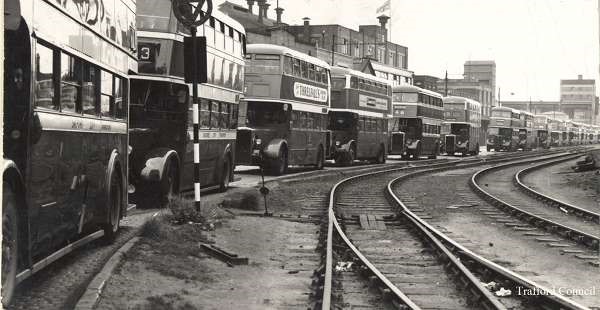
Buses on Westinghouse Road waiting to turn right into Trafford Park Road
on 6th February 1963.
Kevin Mullarkey
If you would like to comment on the above please click here
04/03/21 - 06:59
There may not be a need to do so as I believe this is a colour photograph! It appears in many sources and is of both Salford (Green/Cream) and Manchester (Red/Cream) buses. I Will try to point out a source for you (unless someone can beat me to it)
Mike Norris
01/03/21
Route Numbers Down the Vale of Mowbray
I’m a railway modeller who lived for a long time in what was then the North Riding of Yorkshire, now Redcar & Cleveland. I have a small number of United bus models, mostly 1948 Bristol single deckers that have had route number transfers added but I have one more modern one with the route number 34 and Newcastle destination indicator. I’d like to know bus route numbers down the Vale of Mowbray between Darlington and Thirsk or Middlesbrough-Northallerton-Thirsk to renumber the bus route indicator in line with the layout area. Can anyone help?
Alan Lancaster
If you would like to comment on the above please click here
02/03/21 - 06:55
Alan, I have a United timetable for 1960. Unfortunately it only has a destination index (not a numerical list of routes). If you have any specific routes in mind, I can let you know what they were and corresponding route numbers at that time. However I have no idea what types would be allocated to which services. Maybe others with local knowledge can be of more help.
Stephen Ford
04/03/21 - 06:54
I don’t have any local knowledge either, but there is a 1969 United timetable
at https://timetableworld.com/ The 34 is shown as Northallerton-Richmond, so at that date ’34
Newcastle’ makes no sense on a United bus. It did have a stop at Northallerton station, though, if
that’s of any help.
The X99, albeit a long-distance service from Middlesbrough to Leeds, and
then on to Liverpool with a change of vehicle, operated as a local service between Middlesbrough and
Ripon, via Stockton, Crathorne, Northallerton and Thirsk. There was also a 295 from Stockton to
Northallerton via Crathorne and Swainby, and a 296 with a more westerly route via Appleton Wiske.
The 296 was just two journeys on Wednesdays and three on Saturdays extended to/from Middlesbrough.
That’s all I’ve been able to find. You may get more local knowledge by posing the question on
the message board at www.sct61.org.uk
Peter Williamson
05/03/21 - 06:41
United did quite a lot of service renumbering and in 1964 the 34 was a Darlington to Neasham service. There was also a different 34 - I think Northumberland area services originally had a separate series. This 34 was a Carlisle to Newcastle service which became the 334 and I suspect that is what the model was displaying.
David Beilby
05/03/21 - 06:43
The Bristol SU I’ve got a model of had the destination section at the top ("Newcastle"), the route it took (’93’ I think, I’ve changed the destination to ‘Northallerton’ since I bought it) and the places en route, (Brampton, Haltwhistle, Hexham) in the bottom box about twice the depth of the top box. Don’t know which of the SU’s this might be, but they must’ve used this bus type in other areas, in the case I refer to being Northallerton. The originating point isn’t important as it can be changed from Harrogate. There’s a choice of originating points, Middlesbrough and Darlington being two, Stokesley being another.
Alan Lancaster
26/02/21
Rust in Peace
Could anyone ID this bus please, seen better days lol but just interested in what it is.
Dave
If you would like to comment on the above please click here
27/02/21 - 05:55
Bedford VAS. Most probably VAS5. Plaxton Panorama I. The badging and marking would suggest 1967/8.
David Oldfield
02/03/21 - 07:00
The badge certainly looks as if it says Panorama I, but the trim lines and opening window say it’s a Panorama II. Here’s another: www.busphoto.co.uk/
Peter Williamson
02/03/21 - 14:26
Peter. You’re absolutely right. Missed the sliders. Maybe the badge has had one of the I broken off.
David Oldfield
22/02/21
Please Help me to Identify this kind of Bus
I am writing to you because I am not able to identify this kind of model and manufacturer of this bus. But i knew that this image was taken from 1925 in Cambodia by a British photographer James Dearden Holmes (1873-1937). Holmes travelled the world for three years and his trip has been dated from immigration records to 1925-1927.
Bo Sophea
If you would like to comment on the above please click here
09/03/21 - 05:00
Cambodia was a French colony at the time, so that’s a likely starting place,
as colonies mostly took products from the mother country. This 1924 Berliet linked below looks to
have many of the characteristics in the photograph, including the manufacturers scroll name at an
angle and underlined. Berliet were long one of the mainstream French bus manufacturers.
www.alamy.com/stock-photo-berliet-hotel-bus-type-vha-1924
Chances are
that the chassis was exported but the body was locally built of timber. At that time there was a
blurring between the chassis of large cars and small buses.
Bill
19/02/21
United Half-Cab Single Deckers
I was a youngster in Redcar in early 1950’s, strictly United territory, and would like to see a photo of my favourite which from distant memory was a half-cab with front door set back so that there was one seat with a view over the black mudguard. Quite exciting for a youngster to have such a good view of the road ahead! Hope someone can oblige.
George Robinson
If you would like to comment on the above please click here
22/02/21 - 13:19
It has been a few days since George posed his question although there have
been no responses so far. Whilst I can’t directly help I thought to mention that the story of Redcar
bus station has been featured over the past couple of issues of ‘Classic Bus’ magazine (issues
170/171). Unfortunately the articles only feature a photograph of one (pre-war) half cab single
decker but the other content might be of interest.
The following link might help identify the
type of bus he asked about: www.sct61.org.uk/index/operator/ua
David Slater
15/02/21
Lodekka Conundrum
Here’s one for Bristol Lodekka aficionados…
I remember this particular Hants & Dorset
Bristol FS from my childhood because it had something I have never seen on any other similar bus of this
type in the UK… an opening top vent in the rear emergency door window. Can anyone enlighten me?
Was it an option from ECW that hardly any operator took up or was it a one-off Hants & Dorset
experiment? I can’t see any reason for it!
Colin Plucknett
If you would like to comment on the above please click here
27/10/21 - 06:28
I’m not sure that this is an opening window, as its height does not appear to
be the same across its length. The photo was taken on a sunny day. I think that you can see through
the rear window, onto the platform, where you can see the vertical grab rail to assist passengers
stepping up onto the platform.
Then you can see further through the platform window into the
lower saloon, and over the longitudinal seat over the wheel arch.
I suggest that what you can
see in the photo might be the handrail on the top of the last transverse seat on the nearside. It
certainly looks like a regulation ECW handrail to me. Do others agree?
David Allen
28/10/21 - 07:00
David, I can see where you are coming from regarding the shadows and
reflections in the attached photo, especially given the strong sunlight, but there also appears to
be a strong shadow across the emergency exit window rubber, presumably from the open ventilator
above. The ‘j shape’ seen through the glass could also be from the cream rubber window
surround of the folded open platform doors. Could what seems to be a seat handrail through the
emergency exit door glass actually be the lower part of the ventilator frame?
Colin, I
remember your original posting about this fascinating modification/experiment under "Hants &
Dorset - Bristol Lodekka - 7678 LJ - 1478" on this very website. Your memories of the rear vent
being on a green-liveried Lodekka FS with cream window rubbers tie in nicely with the photo, and
although it’s difficult to make out the full registration, the letters look to be ‘RU’, which
narrows it down to the batch of twelve FS Lodekkas delivered in 1963/64 (1488-1499: 4688-4699 RU).
Narrowing it down a little further, although the last two numerals on the registration plate are not
clear, I think we can discount 4691/4/7 due to the shape of the last numbers. In your original Hants
& Dorset posting, Geoff Cummings responded by recalling the vehicle you mentioned, and that he had a
photo of it somewhere. He also said he was certain it was a Southampton car. (Sorry - slipped into
West Yorkshire speak there!).
Brendan Smith
28/10/21 - 07:10
David - I don’t think so! The question refers to the narrow opening section at the top of the nearside window on the lower deck rear. It is admittedly quite shallow, but I suspect that it appears shallower than it really is, because it is open!
Nigel Frampton
29/10/21 - 06:44
Colin. Good news! To try and widen the discussion a little further regarding the unusual vent, I posed your question on the SCT’61 website. Contributor Nigel Frampton kindly did a bit of delving and states: "According to the PSV Circle history of Hants & Dorset, a push-out vent was fitted to the lower saloon rear emergency door of 4688-4690RU. That in 4690RU had been removed by August 1972". So there you have it - there wasn’t just one bus so fitted, but actually three!
Brendan Smith
29/10/21 - 06:45
In the meantime, I have checked the PSV Circle history of Hants & Dorset, and this explains that three vehicles were fitted with this feature - 4688-90RU. These three vehicles also had driver-controlled four-leaf doors, while earlier Lodekkas in the H&D fleet had two-piece doors, which were manually operated by the conductor. The extra opening window was presumably fitted in connection with the type of door; however, 6 Bristol FLs that were delivered before the FSs also had the four leaf doors, but not this unusual opening window.
Nigel Frampton
23/12/21 - 06:16
I consulted Phil Davies, who has a lot of ‘further detail’ in his records than could be published in the Hants & Dorset PSV Circle fleet history, which he wrote. He writes (and gives permission for it to be posted here) that he is "certain that this was an H&D ‘special request’, and as far as he knows, no other fleet had them., and there were 4 in the H&D fleet. The first was retro-fitted to 1456 (4379 LJ)in 11/62. As far as Phil knows, 1478 (7678 LJ) was never fitted with this feature. 1488-90 (1488-90 RU)were built with these rear vents by ECW in 1963. All 4 vehicles had power doors under driver control, and these rear vents made a difference to the air conditions on the rear platform, although some crews would ‘come to a verbal arrangement’ on hot days to have the doors left open whilst on the move. The view is that the vent was not fitted to later batches was that the ‘bean counters’ (to use Phil’s phrase) under THC control discontinued such ‘special features’ for particular operators.
Peter Delaney
11/02/21
Which Sunbeam Trolley Bus Model
Is there someone who can give me some advice please?
I collect Guy related items because my Dad
worked for Guy Motors in their truck and bus division. I realise that Guy took over Sunbeam in 1948 and
continued to produce trolley buses under the Sunbeam badge and
I would like to add a Sunbeam
trolley bus model to my collection. I think there are two possible candidates out there, both by Corgi.
Corgi Wolverhampton Corporation OOC Sunbeam Roe Trolley Bus Model OM40102B at scale 1:76.
Corgi Reading Corporation Sunbeam Trolley Bus Model 97800 at scale 1:50.
My question is, which of
these two models if any has the closest connection to Guy?
Keith Allden
If you would like to comment on the above please click here
11/02/21 - 13:55
The Wolverhampton model represents one of the 1947-built Sunbeam W chassis
which received new bodies by Roe between 1958 and 1961.
The Reading model is one of the
Sunbeam W vehicles with Park Royal utility bodies built in 1943.
Both are therefore vehicles
which were built before Sunbeam were taken over by Guy Motors.
Sunbeam trolleybuses continued
to built at the original Sunbeam facility in Wolverhampton until 1954 when production moved to a
purpose built section of the Guy works at Fallings Park. (see Wikipedia https://en.wikipedia.org/wiki/)
Alan Murray-Rust
09/02/21
Bus in the Background
The attached picture is my auntie Jean, not that that’s of particular interest to you! I’d be very
grateful if you could identify the “bus”, if I may call it that, in the background. It’s obviously a
very old pic so quality not brilliant. If I can ID the bus that may give me a clue as to where and when
it is.
Some clues - she’s a Yorkshire lass! She was born in 1935. If the baby was me then that’d
make her about 15, but I think she might be a bit older than that there. If it were my brother it’d be
circa 1953 so she’d be about 18 which is more like it.
So it could be Yorkshire in Barnsley area.
Or it could be St Albans area where my brother and I hail from.
Now there’s a good
challenge for you!
Graham Arnold
If you would like to comment on the above please click here
09/02/21 - 13:30
Is there any connection with Cubley Hall, Penistone, in your family?
The building has a look about it which I remember from my childhood.
John Lomas
05/02/21
AEC Regal of Pyes of Blakeney KVF 262
I’m trying to find out information about this vehicle which my friend Trevor Brooks (from Colchester) took a photo of at Wells Sec school waiting to take some children back home to the Blakeney area. It was 1969 and I was driving the Carley’s Bedford parked beside it. We were told by the driver that it had been in an accident with a car which had been written off with virtually no damage to the coach. Trevor thinks it could have previously been owned by Cullings because there was some yellow paint showing.
Peter Thatcher
If you would like to comment on the above please click here
06/02/21 - 06:26
KVF 262 was an AEC Regal 9621A with Plaxton C33F body new to Cullings in March
1950. It was sold by them in November 1960 and passed to North Norfolk Garage Ltd (trading as Pye’s
Garage) of Blakeney. They became R. C. Smith (trading as Pye’s Garage) in January 1967.
Unfortunately, my story derived from PSV Circle record cards doesn’t go beyond that date so still
may not fully answer your query.
David Beilby
06/02/21 - 06:28
Trevor Brookes is correct, it was new to Culling of Claxton in March 1950. I will post further details in a couple of days if nobody beats me to it.
Nigel Turner
06/02/21 - 06:29
According to BLOTW it was indeed new to Culling of Claxton in March 1950. Plaxton body. "Buses in scrapyards" website says, "KVF 262 was a 1950 AEC Regal III that spent it’s entire life working for Cullings Coach Services of Claxton near Norwich. It ended life in a field." The photo suggests that this is not quite right.
Stephen Ford
10/02/21 - 07:01
The PSV Circle information I have indicates that it remained with Pyes (Smith) of Blakeney until it went to Ben Jordan’s scrapyard at Coltishall in November 1970. This must have been one of the last half cab single deckers in service by then.
Nigel Turner
14/02/21 - 09:54
Further to my query regarding the Pye’s AEC of Blakeney, may I firstly give my thanks for the response. Now would there be any knowledge of the Carley’s Bedford which stands besides the AEC? I was driving it (1969 July) and on the return trip to Fakenham, via Walsingham and Barsham, dropping the last passenger at East Barsham, the gearbox failed. It stuck in 4th gear. Phone call from the near-by phone box brought engineers out from the garage who tried unsuccessfully to get the vehicle up the hill starting in 4th gear by slipping the clutch, eventually succeeded in rescuing the coach by hitching a landcover to the front and towing it with the coach being driven by slipping the clutch. Was this the demise of that coach? I have a suspicion it was because I seem to remember driving a Commer after that.
Peter Thatcher
18/01/21
Imperial Garage
I would be very interested to find out what types of busses are in this photo - and what era it would
be.
Imperial Garage was owned by my great Grandfather.
Andrew
If you would like to comment on the above please click here
19/01/21 - 09:49
The period would by late 1920s-early 1930s. I believe that the vehicle on the right is VR 4044, an AJS Pilot new to an operator in Bootle in October 1929. Was this business based in Bootle?
David Hick
20/01/21 - 06:42
Is this garage in Leyland Road, Southport?
Paul Robson
21/01/21 - 06:17
This is how Imperial Garage in Leyland Road, Southport appears today - https://tinyurl.com/y495gy2v There are similarities with the building
shown in the photograph.
PSVC publications (AJS chassis list and British Journal) show VR4044
as an AJS with unknown B24- body, new -/29. First owner not known, second (or subsequent) owner
unknown at Bootle 10/29, next owner JI Jones, Cesarea 5/37?, void 12/43.
VR 4044 is a
Manchester registration, suggesting that either the first owner or the dealer was based there.
David Williamson
22/01/21 - 07:35
There does seem to be similarities between the two garages, and having the same name would seem to put the Southport garage "in the frame" but there is no clincher-for example there is no evidence of the Southport garage having had larger doors, and it seems to be set further back from the road. The legal lettering on the vehicle on the left reads W. Whalley, Imperial Garage with the town name appearing to end "ton".
David Hick
22/01/21 - 17:00
Is it possible to enlarge the legal lettering on the side of the first bus in the original pic? That might give us a clue.
Roger Cox
23/01/21 - 05:32
The address is Ingleton in Yorkshire. They applied to Yorkshire Traffic Area
in October 1931 for a licence to continue existing stage services from Ingleton to Lower Bentham &
Burton Lonsdale. Their application was refused. Ribble Motor Services were the objector.
An
ariel view of the garage in the 1960s can be found here: www.facebook.com/groups/
David Hick
23/01/21 - 05:34
Having enlarged it to the point where it becomes unintelligible, it looks like INGLETON to me.
Chris Barker
23/01/21 - 05:39
Possibly it says Ingleton.
I was, however, hoping that Andrew would
tell us where it is.
Paul Robson
23/01/21 - 12:24
Following the link to the Facebook Group given by David Hick I then expanded
the comments of which this was one:
From Derek Procter, The garage was Harold Whalleys, he lived with his family
in the nearest semi to the left called I think Whitehaven. To the right is the old Fiddlecase plot
with the Settle RDC yard to the left.
Another comment reads- "Its all houses now".
The large house
adjacent to the garage in the photograph still stands but new houses now surround it.
An aerial Google Streetview shot makes an interesting comparison with that on
Facebook: www.google.co.uk/maps/One
(The
Facebook page contains the name Peter Bibby. I wonder if he is connected with the coach operator
Bibby’s of Ingleton Limited? Their garage is on the left of the Streetview shot).
Another little item which was part of the Ingleton transport scene was a dormitory shed once used by Ribble Motor Services (and possibly shared with Pennine Motor Services). That is close to Bibby’s but on the opposite side of the main road (A65) to Imperial Garage. In the Streetview image, which dates from 2014, the building has a ‘Sold’ sign on it. It might now no longer exist but a link to the view is: www.google.co.uk/maps/Two
Here is a snapshot I took of that building in September 1974 with a Ribble single decker inside.
David Slater
04/02/21 - 12:27
Thank you for all the comments - sorry I have not responded sooner.
Yes
it is Ingleton, Yorkshire.
I believe that the young lad at the back of the first bus is my
father. I think this building still exists see photo above.
Andrew Whalley
04/01/21
Heaver Coachworks of Durrington
My wife is the great granddaughter of John Thomas Heaver who founded Heaver Coachworks of Durrington. I
am trying to track down any of their old buses/coaches and from your article on ex Guernsey Motors 77
Albion with the reading (Heaver design) body, I hope you might be able to help.
Grateful for any
assistance you might be able to offer
Ian Buglass
If you would like to comment on the above please click here
05/01/21 - 06:59
Try:-
Coachwork by Heaver Ltd
Stock Code JCG03.0
Author
Carman J
ISBN13 NO ISBN
Height(mm) 210
Width(mm) 148
Page Count 80
Publication Date 21 Mar 2011
Publisher JOHN CARMAN
Publication Status Out of print
Andrew Charles
05/01/21 - 12:16
Can’t help with tracing any extant vehicles, but here is a collection of photos of vehicles with Heaver bodies - https://tinyurl.com/y3ucgqhs
Chris Hebbron
21/12/20
Leeds City Transport 5228 NW
Yesterday, in the yard of a commercial garage at Rushall, near Diss, Norfolk, I saw a double decker bus in very poor condition. The index number was 5228 NW. NW was first registered in Leeds. I am assuming this bus was once operated by Leeds City Transport. Is anyone able to tell me anything about this bus,
David Wolfenden
If you would like to comment on the above please click here
21/12/20 - 11:31
Leeds-registered 5228 NW was indeed a Leeds City Transport bus. It’s a Leyland
PD3/5, with Roe bodywork, new in 1958.
It ended it’s days [by 1976] with Leeds as one of
their Driver Trainer buses. There’s a photo of it in this role on the SCT’61 website. If you go to
the search section and use the registration as your search key, it will appear. Another of the
batch, 221 [5221 NW] appeared at the 1958 Commercial Motor Show, with a more enhanced livery. It
appears the batch as delivered seated H38/32R. Hope this helps.
Michael Hampton
21/12/20 - 11:32
There is a photo of this Leyland Titan PD3/5 here //www.sct61.org.uk/ld228
John Lomas
22/12/20 - 11:52
It was one of seventy-one, 221-291, 5221-5291 NW which were new between
November 1958 and April 1959. As delivered they seated H39/32R.
Between August and October
1960 they were re-seated to H38/32R following a Union agreement on standing passengers, which
limited standing to five passengers on buses with more than seventy seats but allowed eight standing
on buses with not more than seventy seats.
Leeds therefore opted for 70 + 8 rather than 71 +
5. A double seat was replaced by a single seat and the removed double seats used on a later batch of
new buses
John Kaye
03/01/21 - 06:57
I sent a message to this website asking for information about a bus that I had seen. The index no, was 5228 NW. Several people were kind enough to answer my query and I thank them for that.
David Wolfenden
13/12/20
Date of Photograph Required
I would be vary grateful if someone is able to date this photograph for me please. I have been told it is of my Gt Gt Grandfather John Williamson of Bridlington standing on the steps in a bowler hat. His son Reuben is on the right hand side of the photo and John Sawdon of Bridlington who died before 1912 is on the top of the bus. Maybe some expert could help me by assuring me these dates tie in with the photo please?
Cathy Goldthorpe
If you would like to comment on the above please click here
20/01/21 - 06:59
The vehicle depicted is an Herald 40hp BT 253. It was new to J Williamson 4/09, being withdrawn during 1911. The body was previously mounted on a horse bus. The disposal is not known. The date is April 1909, the bus was being shown off to the local council and press.
Keith Easton
21/11/20
Bus Trip from Selby Golden Lion Pub to Wembley?
Would anybody be able to give me an idea when this lovely old photo was taken? Perhaps from the two busses. They are outside the Golden lion pub in Selby. On Millgate it includes the father of a lady who gave me the photo. She was 91.
Gavin Wright
If you would like to comment on the above please click here
21/11/20 - 09:48
The coach operator is Bullock & Sons of Featherstone they had a garage in Selby. The photo would appear to be early 1930’s. It could be that the coaches are a pair of Daimlers delivered in 1930 if the radiator head is fluted (difficult to see in the photo).
David Hick
22/10/20
JCJ 752, Bedford SB, Duple C33F
Probably a long shot; Does anyone have a photograph of JCJ 752, Bedford SB 8097 Duple C33F 1016/13. This was new to a local operator, Richards, Newcastle Emlyn (probably J D Richards of Beulah I think) in 1952. According to the info I have, the coach was sold to How & Moorcroft, Whitchurch, Hants 11/54 (very soon after Mr J D Richards died). Sold again in June 58 to Parfitt, Rhymney Bridge. They sold it 7/61 to Taylors, Sutton Scotney, Hants. 5/65 it was with Merlyns, Skewern. 9/66 it was almost back where it began, down the road at Gwalia, Llanybydder It seems odd that it went from Wales to Hampshire, back to Wales, back again to Hampshire and then back to Wales again. Can anyone please confirm (or otherwise) the accuracy of this history?
Les Dickinson
If you would like to comment on the above please click here
03/02/21 - 06:32
JCJ 752 was with Arnold’s Coaches of Whitchurch Hants in 1959 and 1960. It was still in How and Moorcroft colour scheme as were the OB’s transferred from from H & M. Not sure it was in Wales between 1957 and 1961, unless it was a short time. Was a regular on Whitchurch school annexe shuttle in 1959 and 1960.
Fred North
21/10/20
Treasure Family Outing 1963
I’m behind the steering wheel. Mam’s in what we called the co-pilot’s seat. Dad’s taking the picture. My eight brothers and sisters are all present. My father had kitted this vehicle out with a kitchen and bunk beds, leaving enough seats at the front for all of us, plus the odd hitchhiker. I believe it was a 32-seater. I’d be grateful for any other information.
Joe Treasure
If you would like to comment on the above please click here
22/10/20 - 06:50
Hello Joe. I can’t tell you anything about your Guy bus, I shall leave that to
the many esteemed knowledgeable contributors to this great nostalgic site.
No, I was moved to
reply and just wanted to say what a truly wonderful family photo you all made!
What a
treasured (for the Treasure family!) heirloom of a seemingly more simple, carefree loving era which
I well remember too.
Many thanks. You’ve made my day!
David Smith
22/10/20 - 06:51
Must have been a great childhood!
According to PSV Circle lists this
was a Guy Vixen chassis number LLV40709P probably 1949, and was bodied by Withnell who used it as a
demonstrator (on trade plates?). They sold it to Barr & Sons - Agricultural engineers - Sandon near
Chelmsford. They later sold it to H G & R Boon of Boreham. It seems that this is when it was first
registered as 4337 NO (June 1958).
Les Dickinson
23/10/20 - 06:33
Putting aside the Circle’s inventive nonsense, this was the coach that nobody
wanted for a long time! It was indeed bodied by Withnell over in Shotton, north Wales in 1948/9 but
it failed to find a buyer and was stored unused for years. It was over in Essex by 1954 being
advertised for sale as ‘new, ordered in excess of requirements’ for £1750. Eventually Boon of
Boreham, near Chelmsford, took pity on it but they only ran it for a couple of years and it was next
heard of ‘disused at Charlton Kings [Gloucestershire] in 7/65’ after yet another prolonged
‘absence’.
How splendid that it finally found a good home and was cherished! So Joe,
where were your family based - did they eventually leave it in Gloucestershire?
MartinI
23/10/20 - 06:34
The Withnell body is indeed listed as having 32 coach seats. I think the
initial operator was probably just Robert Boon, I don’t think his son Hector became a partner until
the 1960s although I could be wrong. Boon withdrew it in September 1960 and the PSV Circle list it
with Treasures’ Travel, Charlton Kings as a caravan by July 1965. It passed to "Carrigan",
address unknown by January 1973.
Letch of Sible Hedingham had a similar vehicle OPU 153 new
in April 1949.
For completeness, I think the children featured are Anastasia, Thomas, Mary,
Mark, Patrick, Joseph, Wilfred, Elizabeth and Joanna together with their mother Margaret.
Nigel Turner
02/10/20
Wartime Image of an AEC Regal
I have found this wartime image of an AEC Regal in use by the Wehrmacht during WWII. I believe they
captured it following Operation Dynamo and the evacuation of the British Expeditionary Force in May/June
1940. Despite attempts by the retreating troops, the Germans were able to repair and then use the
vehicles they found. This included coaches but photos of these are very rare.
My question is, can
anyone identify the bodywork and suggest a possible original owner?
Bill Headley
If you would like to comment on the above please click here
05/10/20 - 06:31
It had a Metcalfe body and is generally thought to have been JD 9472.
MartinI
06/10/20 - 06:43
The JD vehicle registration was allocated, from 1929, to West Ham, London, also the first production year for this AEC Regal I.
Chris Hebbron
06/10/20 - 06:44
Any idea of its’ pre-war history?
Bill Headley
23/10/20 - 06:41
JD 9472 AEC Regal 6622588 was new to Essex County Coaches, E15 in 5/38 and is assumed to have passed to the WD 1939/40 and then ‘lost’.
MartinI
24/10/20 - 06:28
Metcalfes (London) Ltd, had premises in Regent Street, London and their works, called Lincoln Works, in Romford Essex in 1924. By 1928, it had expanded with Stuart Works at Hamilton, Lanarkshire, Scotland, where it built over 150 bodies for the Glasgow General Omnibus & Motor Services Ltd of Hamilton. They built single-deck bodies, including a so-called "sun & air salon" and a 32-seat service bus called the Mastiff, fitted to the AEC Reliance chassis. By 1938, it had become F. Metcalfe & Son and was still building bodies in 1938. I can find no further trace of the company. Even if the vehicle survived the war, it was unlikely that it would’ve been repatriated. After VE Day, many UK single deck buses/coaches were requisitioned and sent abroad for use by British administrators etc who were sent to mainland Europe, especially Germany.
Chris Hebbron
31/10/20 - 06:31
Interesting that the only modification that the Germans have made was to obscure the AEC badge!
Petras409
07/09/20
Former East Kent Single Decker
As a student back in 1968 I had a couple of trips on this ‘preserved’ ex East Kent single decker owned by an acquaintance. Please can any of your expert contributors and experts tell me anything about it and does it still exist?
Roger Monk
If you would like to comment on the above please click here
08/09/20 - 06:31
This is a Dennis Lancet J3 of 1949 with a Park Royal body, delivered as B32R but later upseated to B35R. The postwar Lancet was very closely related to the prewar Lancet 2 version, but the four cylinder 85bhp O4 engine of 6.5 litres was replaced by the six cylinder 100 bhp O6. The advanced O6 power unit of 7.58 litres, exactly the same capacity as that of the well known AEC 7.7, had four valves per cylinder and no other contemporary British manufacturer ever made a four valve engine in quantity. The engine also had wet liners which gave no trouble whatsoever, and the efficient gas flow properties of the four valve head, together with the high standard of engineering and balancing of components resulted in the O6 engine being the smoothest running diesel engine of its time. Curiously, Dennis retained the archaic style of radiator and unnecessarily high bonnet level of the pre war Lancet in the post war model, despite having designed and manufactured a much more modern front end for the closely related double deck Lance K2/K3. One Lance chassis was bodied as a 33 seat forward entrance coach by Santus in 1947 for the L.F. Bowen fleet in Birmingham, and its appearance was a major improvement upon the Lancet. East Kent were confirmed aficionados of the Lancet in pre and post war years, and got excellent service out of them. In 1959 the operator rebuilt 26 of their Lancets with a full front and forward entrance for one person operation, and these modified buses gave a further six to eight years of reliable service. Happily CFN 121 still survives.
Roger Cox
09/09/20 - 05:58
My thanks to Roger Cox for supplying the information on this vehicle. Glad to hear it’s still around after all this time.
Roger Monk
06/09/20
I have been scanning another batch of my late father’s bus slides. This one was taken on 23rd April 1965 in a road-side cafe(?) lorry/car park at Abergavenny. I wondered if any of your contributors might have an idea what it could have been doing there. I think there appears to be a large poster in the nearside rear window; could it have been in the process of delivery from the body builders - new, as I believe ‘C’ was the registration suffix for 1965. Is that quite late for a traditional exposed radiator rear entrance d/d?
Roger Monk
If you would like to comment on the above please click here
06/09/20 - 16:56
You’ve answered your own question correctly. This is a Leyland PD2/40 on delivery from Massey Bros, Wigan. There were a good number of Titans with rear platforms and exposed radiators delivered to various operators up until the last, a PD3, delivered to Stockport in 1969.
Phil Blinkhorn
06/09/20 - 16:57
According to B.L.O.W.
This was a Leyland PD2/40, chassis number L24300,
with an L27/28RD Massey body, number 2633, new to West Monmouthshire in April 1965.
Ronnie Hoye
06/09/20 - 16:58
That’s a lovely picture, Roger, of a very shiny 15. It will be new as it is
recorded as being new in April 1965. It wasn’t the last of these delivered to West Mon - they had a
further one later in 1965 and a final one in 1966. 15 was the first PD2 in the fleet to feature
fluorescent lighting.
West Mon were not the only operator buying buses like this in South
Wales, as Caerphilly UDC had three lowbridge PD3s in 1965 followed by two PD2s in 1966. The last
lowbridge bus of all was a PD3 new to Bedwas & Machen UDC (6 - PAX 466F) in 1968, not far off being
a G-suffix!
David Beilby
07/09/20 - 06:21
Many thanks to the guys who have responded to my question.
Dave Beilby
would probably be interested to know the photo was taken on the way back from an industrial railway
‘gricing’ trip around some South Wales collieries, etc. A few buses were captured on the same
trip.
Roger Monk
18/08/20
North Western Bus at Biddulph
This North Western bus ran on the Biddulph to Congleton route throughout my childhood and early teens.
The photo was taken outside Biddulph Public Hall in the late 1950s before the Public Hall was
demolished. It looks like the conductor is changing the destination for the return journey to Congleton.
Can anyone please identify the make and model of the bus, I would love to know!
Steven Radford
If you would like to comment on the above please click here
19/08/20 - 07:24
The bus is a Bristol K type with a Gardner engine. It dates from 1939 and was rebodied by Weymann around 1951. It probably saw service until around 1964. There were five of these at North Western’s Biddulph garage, fleet nos 418, 428/9, 455 & 457. The route to Congleton was service 25 via Whitemoor and Congleton Stn. A similar one is preserved at the Museum of Transport for Greater Manchester.
Orla Nutting
19/08/20 - 07:25
It is too difficult to see the registration of the Car (North Western never called them buses) but it is of the 1939 batch of Eastern Coachworks, Lowestoft, bodied Bristol K5Gs that were totally refurbished and rebodied by Willowbrook of Loughborough in 1951. This photo is post 1958 as the vehicle is in spray paint livery with red roof. It is on the every 20min 25 service Biddulph to Congleton (slight regular variations to terminals). Possibly the photo is by Anthony Moyes? He was a regular photographer around here at the time and is a good friend. The original print will be a lot clearer.
Robert Bracegirdle
19/08/20 - 07:25
I’m pretty certain it’s a Bristol K5G with Willowbrook lowbridge body.
Stephen Ford
19/08/20 - 07:26
The vehicle in question is a Bristol K5G
Andy Johnson
21/08/20 - 05:44
Thank you so much everybody for all your valuable insight. Now I know what I was travelling on all those years ago, which incidentally was worth every penny of the 6d half-fare to get to Congleton! All the very best.
Steven Radford
20/07/20
Coach near South Emshall
This popped up from someone’s photo album; it’s taken on the Doncaster to Wakefield road years ago. I’m sure someone’s going to be able to identify it easily for him.
Peter Morris
If you would like to comment on the above please click here
21/07/20 - 06:35
I think it should be South Elmsall (pronounced Em-sal) although it is some distance away on the A638: the photo looks to be near North Elmsall! There were a lot of independents round there.
Joe
24/07/20 - 07:00
It was NHA 470 an AEC Regal III - Burlingham C33F which was given a full-front by Jaques Coachworks of Bentley, Doncaster while with Wm Walker, Hexthorpe with whom it is pictured.
Martin
02/07/20
H Brown and Sons
I have been researching my family history and am aware we owned a coach business in 2 Leominster Road, Sparkhill, Birmingham; under the name H Brown and Sons. I have tried to research the company to no avail and was wondering if you could help or at least point me into the right direction.
Niamh Rudge
If you would like to comment on the above please click here
03/07/20 - 06:07
Of course, the name on their coaches might not have been the same as that of the registered company. If you have a year or period, for more info, you could try Kelly’s Directory for that area. Maybe the local reference library or family history group would hold copies for that period.
Chris Hebbron
03/07/20 - 06:09
The PSV Circle / Omnibus Society Publication 2PD11, ‘Fleet History of
the Licensed Coach Operators of the Cities of Birmingham and Coventry’, includes the following brief
description of this operator.
H Brown and Sons (Birmingham) Limited, Leominster Road,
Birmingham, 11. Livery: Green/Grey.
"Mr H Brown was one of the many small operators of
the 1920s. Since then, the business has developed slowly, but is still compact. Originally operating
from 824 Yardley Wood Road and later from Haunch Lane, Mr Brown moved later to 86 Grove Road,
Sparkhill and finally to garage premises at Leominster Road, Sparkhill".
Current
licence: Excursion and Tours, D6619, from Birmingham (Leominster Road).
There then follows a
list of coaches operated during the existence of the business, showing that they had operated a
total of 45 coaches, with a current fleet of five Bedford coaches at the time of publication,
September 1978.
I don’t know whether there has been an updated version of the
publication.
David Williamson
19/06/20
Leyland TD5 EVU 522
Do you know of any surviving pictures of a Leyland TD5 bus with the registration EVU 522?
The
reason I am asking is that a few years ago I purchased a wooden plaque with the service number 3792 and
it has a button on the bottom which says Press once (I presume this was the STOP button). The reason I
bought it is because it was made by Crossley Coachworks and I have a interest in the Crossley motors
company (though granted I am more into their cars than buses).
I contacted the Crossley register
and they have informed me it is in fact from a Leyland TD5 which had coachwork made by Crossley and that
it was in service in Manchester in 1938, with the original service number of 792 which was changed to
3792 in 1948 and the bus stayed in service until it was scrapped in 1958.
Jake Hutley
If you would like to comment on the above please click here
20/06/20 - 05:58
There may be photographs somewhere, but the link is to one from the same batch which I took in 1955. www.sct61.org.uk/
John Kaye
13/06/20
Pride of the Road
Attached is a photo of my father with a bus he used to drive. I think it was in the 1930s and it may have been in the Grantham area, but I am not sure. Has anyone any idea as to the make of the bus, the possible dates and who the owners might be.
Roy Draper
If you would like to comment on the above please click here
1/76 models of a Leyland TD 4 or 5
I’m wondering if any of your readers know of any 1/76 models of a Leyland TD 4 or 5. I’m looking for one to convert into a Maidstone & District recovery vehicle based on the attached photo. Thank you.
Paul Cornish
If you would like to comment on the above please click here
13/06/20 - 06:43
The only TD4 I’m aware of is an EFE model of the London STD class [pre-war], their ref 33601. The body shape is the same as the AEC STL version. Be aware that EFE have also made a model of a post-war London STD, which is a PD1 with Leyland body [Refs 20201, 02, 03]- not what you need! Apart from the Leyland TD1 by EFE, there are hardly any models of pre-1939 buses in 1/76. EFE did also model a Leyland TS8 saloon with BET-style body - 183xx and 184xx series. If you are altering a model, this could be a possibility, as the TS8 is fairly contemporary to a TD4 or TD5.
Michael Hampton
14/06/20 - 07:59
I don’t know where one might acquire such a thing now, but Anbrico Kits, from Pudsey used to do a model of the Southport open topper.
Pete Davies
29/05/20
Macclesfield Bus Station
I’m trying to date a photograph of Macclesfield Bus Station.(North Western Road Car Co.)
I
wonder if anyone is able to give me a likely range of years for the attached photo?
Chris Eccleston
If you would like to comment on the above please click here
31/05/20 - 06:43
This photo, the copyright of which seems to belong to the Greater Manchester Transport Society, has been published a number of times. The double decker is Roe bodied Guy Arab II BJA1 36, fleet number 17, the single decker on the left of the photo being ECW bodied Bristol L5G AJA 190, fleet number 990. Most publications are vague about the date stating "just after the war". The Guy was rebodied in 1950, the Bristol, unhelpfully, was not rebodied before withdrawal in 1953. Given there are no new or rebodied vehicles in the photo, the best answer is between May 1945 and the end of 1946.
Phil Blinkhorn
02/05/20
Charity Shop Postcard
I came across this photo in a box of postcards in a charity shop & can’t identify the bus company can anyone help?
Ian Beswick
If you would like to comment on the above please click here
02/05/20 - 11:58
Think this is Yorkshire Woolen District
Les Dickinson
02/05/20 - 11:58
This is Yorkshire Woollen District, Dewsbury 241, HD 4803, a Leyland TD2 Titan
with a Roe H24/24C body, one of twenty-eight new in 1932. It was withdrawn in 1947, passed to
Wallace Arnold, Leeds in January 1948, and to Williamson, Bridlington in April 1948. Williamson
withdrew it in March 1951 and it went for scrap.
The photograph shows it in Dewsbury Bus
Station.
John Kaye
01/05/20
Malaysia Bus Photo
This is Seremban bus station in the 1950s in British Malaya (now Malaysia).
I’d love to know
what the buses are, please.
Andrew Wood
If you would like to comment on the above please click here
02/05/20 - 06:30
The bus nearest to the camera is a Seddon, a make prolific in Malaya at the time. Next could well be a Commer but the details visible makes it hard to tell. The next two vehicles with similar bodywork to the Seddon appear to have slightly different radiators and the farther one has a different wheel trim which leads me to believe they are Vulcans. Lancashire manufactures did rather well out of Malaya under British rule as Leyland were also strongly represented.
Phil Blinkhorn
02/05/20 - 06:31
The nearest one. I think. is a Seddon. The others are too far away to
identify, I’d say.
I think the third and fourth ones are Seddon’s, too, with proper
radiators.
Chris Hebbron
02/05/20 - 11:58
Georgetown, Penang, also had a long-established trolleybus system, wholly operated with British vehicles, latterly using Sunbeam (Guy) and AEC vehicles until closure in the early 1960s.
Chris Hebbron
04/05/20 - 05:42
Thank you for your very helpful answers!
Andrew Wood
05/05/20 - 05:51
Andrew, there is a superb book called "Bus Journeys through Malaya in the 1950s" published by DTS, which may help to identify these buses. Currently MDS Books have one copy in stock but they have closed for the duration, but you may find one on eBay.
Paul Haywood
06/05/20 - 07:10
There are a number of copies available at ABE books, and mail order is still
working. www.abebooks.co.uk/
The top one shown on the link looked reasonable
though there is a wide price range.
John Lomas
07/05/20 - 06:58
Having managed to find my copy of Fred York’s amazing book it would seem likely the nearest bus was a Tilling-Stevens [usually badged as Vulcans over there but not in this case…] and the other two were Seddons.
Martin Ingle
01/05/20
Plymouth - CDR 742 - 262
I worked as a conductor, driver, driving instructor for Plymouth City Transport/Plymouth Citybus for 31
years. I have friends who regularly ask questions about old buses and generally, I can find out or know
the answer, but today I have to admit defeat.
I have attached a picture of one of our buses from
I think 1930’s or 40’s CDR 742. I was wondering if anyone can tell me the type of bus, and it’s
approximate age please?
Bert Symons
If you would like to comment on the above please click here
01/05/20 - 08:59
Bus is listed as Guy Arab II 5LW number FD26509. Roe lowbridge L27/28R number GO1749 and new 03/1944.
Les Dickinson
02/05/20 - 06:24
CDR 742 was a Guy Arab ll 5LW fitted with a Roe L27/28R body, and was new in March 1944.
Stephen Howarth
02/05/20 - 06:24
Looks very much like a Guy Arab II with a wartime built utility body
Phil Blinkhorn
Three of these Guys were bought by Premier Travel, and one is shown here:- www.old-bus-photos.co.uk/
Apparently their engines were seriously governed down, a practice that some other operators employed
to save fuel (Southdown for one).
Roger Cox
29/04/20
Albion Bus used by Royal Navy in WWII
I’m trying to Identify a bus used as a makeshift aircraft carrier island used in training naval pilots.
My interest is related to airfield vehicles and modelmaking. https://kolesa.kz/one - https://kolesa.kz/two
Know as HMS Spurius www.forgottenairfields.com
I have
already researched trying to discover the make and model, and it looks to be Albion Valkyrie, maybe with
a Cowieson body (the only that could I find with rear opening driver door) as seen on this link. www.flickr.com/
As the buses/coach chassis were made by a specialized
builder, and there were many of them, I couldn’t make a positive identification, as many photos are from
the other side of the vehicles, and don’t show the driver side.
Can anyone help with this
Identification?
Goncalo Mendes
If you would like to comment on the above please click here
08/04/20
Red and White Services Ltd Bus Depots
I’m trying to help my dad by identifying the location of these 2 photos of Red and White Services Ltd
bus depots.
Would anyone know by any chance?
David Waghorn
If you would like to comment on the above please click here
09/04/20 - 07:29
The first picture is a depot I’m not familiar with so I believe it may be Lydney from the size and mix of vehicles present. The lower photograph is Hereford depot.
David Beilby
09/04/20 - 07:31
David.
If you are on Facebook there is a very good group for Red &
White.
I am sure somebody on there will know. https://m.facebook.com/
Stephen Howarth
10/04/20 - 07:15
I have now been able to confirm that the first photo is of Lydney depot, which
was on Hams Road, alongside the bus station which hadn’t been built at the time of the photograph
but is still open today (it would be in the foreground of the photo). The garage closed on 11th
November 1972 and the site is now occupied by a supermarket.
Hereford depot was on Stonebow
Road but the site is now unrecognisable, having been completely re-developed some years ago as part
of the hospital. The depot had closed by the early 1970s, with the remaining allocation
(out-stationed from Ross depot) based at the Midland Red garage.
David Beilby
10/04/20 - 07:16
David, I have been informed by members of the Red & White Facebook group that the depots are Lydney, and Hereford depots.
Stephen Howarth
04/04/20
AEC Regal 1931 Registration Warwickshire
I haven’t been able to trace the location or more details of the operator. My location guess is
Stratford on Avon - within reach of the Cotswolds or Malvern Hills with a 2.30pm departure.
Alternatively, Leamington Spa which I believe has more of the ‘promenade’ setting apparent from
the photo.
An AEC Regal 1931 registration in Warwickshire is the best I can do - operated by
Priory Motor Coach Tours. If anyone has any further information it would be interesting to know.
Roger Jones
If you would like to comment on the above please click here
04/04/20 - 09:28
Priory Coaches were based in Leamington and I seem to remember them still being around in the 70s running a fleet of Bedford/Duple Coaches.
Roger Burdett
05/04/20 - 07:06
Priory Coaches ran several double-deck buses post-war as well. They were still around in 1984, as this photo of an ex Portsmouth Corporation Atlantean will testify. www.sct61.org.uk/
Chris Hebbron
05/04/20 - 07:11
The photograph is pre 1936, because the type of hanging licence badge being
worn by the Driver was withdrawn from 1935 to 1936 when they were replaced by the more common round
PSV Badge.
Roger, would it be possible to have a better quality high resolution copy, so I
could determine the badge number? Thanks.
Peter has my email address.
If possible I
would like to include it on my PSV Badge website. www.psvbadges.org.uk
Stephen Howarth
06/04/20 - 06:48
The photograph is of WD 2322, an A.E.C. 662 Regal with a Willowbrook 32 seat body which was new in May 1931 to Heler & Dumbleton (t/a Priory Coaches), Leamington.
John Kaye
01/04/20
on the way to the Gower Show
I am an admin for a Swansea History group, recently someone posted a picture of a Vanguard double decker bus. Reg, UP 5438. Apparently this was a postcard which had written on the back "on the way to the Gower Show". The reg on the bus is not one normally seen around Swansea for that period and I was wondering if someone on your site could throw any light on this picture. I look forward to your reply. Regards, Robert Roberts. The Swansea History Society.
Robert Roberts
If you would like to comment on the above please click here
02/04/20 - 07:14
The bus appears to be a Leyland Titan TD1 of about 1927-31 vintage. On the
link below (scroll down to page 10) it is alleged that the registration number UP 5438, is
fictitious, and that this was quite common on Leyland photographs. Apparently UP 5438 (a County
Durham registration) related to a Leyland LT2 Lion (i.e. single decker) belonging to Wilkinson of
Sedgefield. The real registration number of Gower Vanguard’s double decker (running number 23) was
WN 3744 which, of course, was a Swansea registration. www.leylandsociety.co.uk/
A brief
mention in Commercial Motor for 18 April 1952 states that the Vanguard company ran motorbuses
between Swansea and the Gower Peninsula from 1910 (a very early date), and that the company was
taken over by the Red and White group in 1936.
Stephen Ford
02/04/20 - 07:15
The vehicle is a Leyland TD1 or TD2 (the change occurred in 1931) with a piano-front body (the upper front looks like a lid-covered piano keyboard), which would also date from that period. The registration appears to be Newcastle-on-Tyne. Why Vanguard, on the Gower, would buy a bus registered there is a mystery. Leyland were in Leyland, Lancs and I can’t think of a bodybuilder In Newcastle, off hand.
Chris Hebbron
03/04/20 - 07:35
I feel sure that I have somewhere read about this bus. I think it was something to do with a County Durham independent - Trimdon Motor Services?
Nigel Turner
03/04/20 - 07:37
This is a bit of a punt at an answer but is based on evidence in the photo and
some reasonable conjecture.
The poster in the upper deck window is the standard promotional
poster Leyland put in new vehicles on delivery over many decades. The scenery in the background is
much more Lancashire than Swansea and the Gower.
Given the false registration this originally
would be a Leyland promotional photo.
Now the conjecture. The bus may have been going
straight to the Gower Show so Vanguard could show off their new vehicle to potential passengers. If
you have information on the dates of the Gower Show that might help put a date on the photo.
The other possibility is that the Gower Show is a red herring and the bus was on the way to the
Commercial Motor Show.
Phil Blinkhorn
03/04/20 - 07:38
This photograph is taken in Leyland and the location is recognisable today,
despite a new section of B5254 road now crossing Balcarres Road (on which the bus is standing) just
where the bus is stopped. Street View shows the current view here: https://goo.gl/maps/
This was very close to the Leyland Works.
David Beilby
03/04/20 - 07:39
There was of course Northern Coachbuilders in Newcastle Chris. They were owned
by Ringtone Tea at one time.
There is a very good book on them. www.mdsbooks.co.uk/
Stephen Howarth
26/03/20
Old Austin Bus
Hello from Ecuador, my name is Ivan Tulcan, I’m a lover of the old buses in my City Quito, somebody in
my Facebook group of old photos of my city uploaded an old Austin bus. I would like yo know more about
this type of bus.
Thank you.
Ivan Tulcan
If you would like to comment on the above please click here
28/03/20 - 06:48
This bus, Ivan, is based on the chassis of the FG truck, built from 1960 until
1968 to replace older Austin and Morris trucks within the BMC group, the company which was formed
after Austin and Morris merged. They were very well liked by operators. When the BMC group later
merged with Leyland, they were badged as Leyland and had Leyland engines.
The FG range went
from 1.50 tons to 5 tons. The smaller trucks had a 2.2 diesel engine, the model above would have had
a 3.4 diesel engine, and the 5 tonners would have had a 5.1 ltr diesel engine.
The unusual
thing about the FG was that it had a specially-shaped cab to allow the doors to be fully opened in
narrow spaces when delivering goods. The doors did not open wider than the width of the whole
vehicle - very clever. It is difficult to see if these doors exist in some form on your bus, but it
is possible. The photo of mine shows these doors clearly.
Another useful thing about the FG
range, was the kerbside windows (those below the windscreen), which was good for parking in
difficult places.
It’s interesting to see an FG as a bus. I think it would have been unusual
in the UK, if at all - I can never recall seeing one and these trucks were very common.
Here’s a link to a short history of the Austin Motor Company: https://simple.wikipedia.org/wiki/Austin_Motor_Company
Chris Hebbron
30/03/20 - 07:35
Merseyside PTE operated the FG in bus format, back in the day this would have
been unusual as the equivalent Leyland PSV option at the time would have been the Cub chassis as
operated by West Yorkshire PTE.
There were of course also numerous examples in the non PSV
welfare vehicle market.
Andrew Charles
31/03/20 - 06:00
Andrew mentions Merseyside’s FG midibuses, although they started service in Liverpool’s green.
Here’s a photo of one of them, bought late enough for them to be Leyland. As Andrew says, the Leyland Cub would’ve been the logical choice, but was not to be.
Chris Hebbron
31/03/20 - 06:01
The Austin/Morris FG chassis was used on a number of UK buses, mainly welfare buses for local authorities. This one (now a camper) NUV 921E was new to the London Ambulance Service www.flickr.com/photos/
John Wakefield
01/04/20 - 07:40
Merseyside PTE bought the two Leyland Redline FG midis in 1974, but the first Cubs entered service in 1981, so would not have been an option for MPTE.
Dave Farrier
03/04/20 - 07:33
Does anyone know who bodied these buses? They made a good job of it, I feel.
Chris Hebbron
06/03/20
Bestway Coaches
With your contributors vast knowledge, would anyone know the origin of Bestway Coaches. Partial Postcard Scan attached.
Richard Boddington
If you would like to comment on the above please click here
27/03/20 - 06:47
Bestway Coaches was the fleet name of Pointer Bros of Kings Lynn and was, I believe, acquired by Eastern Counties circa January 1934.
Nigel Turner
31/03/20 - 06:04
I’m definitely no expert on body identification, but could this be NG 3150, a Bedford WLB with Economy (of Lowestoft) C20- body, new in July 1932 which became Eastern Counties B6 on acquisition of the Bestway business?
Nigel Turner
31/07/21 - 06:17
The Bestway Bus Company was indeed owned by Pointer Brothers and ran out of King’s Lynn during the 1920/30’s. One of the brothers, Lionel P was my grandfather but unfortunately I do not know what type of bus this is. I have a few pictures of other buses he owned but they look older than this one.
Christine Hall
01/08/21 - 05:50
The Eastern Counties Omnibus Company Fleet History published jointly by the PSV Circle, The Omnibus Society and the Eastern Counties Omnibus Society in 1981 quotes that the Bestway business was acquired by ECOC in January 1934. Four vehicles are listed in the takeover:
FE 8691 Dennis 30cwt/Unknown bodybuilder 20 seat - New November 1926 (Not used
by ECOC)
NG 701 Reo Gold Crown/Unknown bodybuilder 26 seat - New May 1931 (Became ECOC
fleet number B7)
NG 3150 Bedford WLB/Economy bodywork 20 seat - New July 1932 (Became ECOC
fleet number B6)
NG 4411 Crossley Eagle/Eaton bodywork 32 seat - New April 1933 (Became
ECOC fleet number CL3)
David Slater
02/08/21 - 06:39
In the light of David’s fleet listing, the picture must surely show the Crossley. The Eagle was Crossley’s first bespoke bus chassis available from 1928 to 1932 and had a four cylinder side valve 70 bhp engine of 6.266 litres with an aluminium alloy head.
Using the trading name of Eaton Coachworks, the firm of Herbert E. Taylor of Cringleford, near Norwich, dated back to around 1890, and produced vehicle bodywork in several styles, mainly for independent operators in East Anglia. This picture shows another Crossley Eagle with an Eaton body, a 1929 example, for Norfolk Motor Services of Great Yarmouth. Norfolk later purchased an Eaton bodied Crossley six cylinder Alpha in 1930, as seen in this Eaton advertisement.
Roger Cox
02/08/21 - 06:40
David Slater has beaten me to it with the list of vehicles that passed to
Eastern Counties from Bestway Coaches. Earlier vehicles were -
PW 8383 Morris 1-ton new July
1926
VF 7384 REO Pullman Junior/ Eaton new November 1929
VF 8974 REO June 1930
CT 8108 REO Pullman acquired secondhand at unknown date.
WW 7699 (not VW 7699 as shown in
ECOC fleet history) details not known.
I’m sure photos of any Bestway vehicles would be
welcome on this site.
Nigel Turner
05/03/20
Matlock Bus(es)
Any chance that someone can identify the bus(es) in the photo? sorry it is not the best quality. Taken
at Crown Square, Matlock, Derbyshire. Definitely post 1927 and pre 1938 that’s the best period that can
be ascertained at the moment although the bus could well be much older of course.
Photo appeared
on a Group Facebook site recently run for and on behalf of ex students from the College in Matlock. The
photo is, of course, way before any of the people were ever in Matlock but they show great interest in
the history of the town.
Gary Hall
If you would like to comment on the above please click here
05/03/20 - 12:47
The bus in the background is from E Williams & Co (Spa Motor Services,
Matlock) who were operating between Matlock and Wirksworth by two different routes. They also ran a
temporary service between Matlock Bank and Cromford following withdrawal of the Matlock Bank tramway
in 1927. The company was acquired by North Western in 1932. The bus in the foreground appears to be
North Western vehicle. The registration is not clear, but the first letter is D, and if it is DB
this was a Stockport registration at that time. The route indicator reads "Matlock Green, Crown
Square, CROMFORD" which fits in with NWRCC’s introduction of Matlock local services in 1927.
The attached links give further details : www.andrewsgen.com/matlock/ www.petergould.co.uk/
Stephen Ford
07/03/20 - 07:08
The bus in the forefront is a North Western Tilling Stevens B10A, one of eighty to enter service in 1929. If the registration is DB 5238 it is fleet number 338.
Orla Nutting
08/03/20 - 06:42
The bus in the foreground is unmistakeably a Tilling-Stevens B10A of the North
Western Road Car Co. The registration appears to be DB 5239, though it might be 5230, respective
fleet numbers being 339 or 330. In either case this is a 1929 vehicle carrying a Tilling B36R body.
No. 330 was withdrawn in 1939, but 339 survived until 1946.
Incidentally, the old Peter Gould
pages are obsolete - Peter withdrew these when he and his colleagues began the Local Transport
History Library project, but they were pirated and put back on the web without his authority. The
place to look now is the LTHL listings; that for NWRCC is:- www.lthlibrary.org.uk/library/PDF-042-1.pdf
Roger Cox
03/03/20
John O Groats Mail Bus SK 1952
Looks like a Bedford WLB chassis, anyone have any further info on it?
John Wakefield
If you would like to comment on the above please click here
03/03/20 - 09:45
The registration dates from 1934. I think that it is a Ford BB as the radiator badge is not right for a Bedford (too small) and the wheel cut-outs are less rounded than Bedford wheels, but match the more triangular shape found on Fords.
David Hick
05/03/20 - 06:37
David I am sure you are right, Here is a pic of another Ford BB coach SN6524 and the front end looks the same. www.flickr.com/photos/
John Wakefield
17/02/20
Early Bus in West Malling
I have this rather great postcard picture of a new bus on West Malling High St does anyone have any info on the date the bus service in question etc as I have only this postcard
Registration is LH/LA 8989
Keith Bullard
If you would like to comment on the above please click here
15/02/20
Bus Near Nottingham
I think this may be a Leyland Lioness about 1930. The Trent was flooded at the time. The policeman is
my grandfather.
It is at Bassingfield, on the A52 about 6-8 miles east of Nottingham.
Does
anybody know what company operated this route?
I’m no expert on buses but a friend is working
this photo up into a painting and it would be preferable to show the bus in the correct livery if
possible.
A. Frost
If you would like to comment on the above please click here
16/02/20 - 05:59
The bus looks too small to be a Leyland Lioness, and it’s probably too early to be a Leyland Cub. But there was a model called the Leyland Leveret, which is a possibility. I don’t have any other info re the operator or colours though.
Michael Hampton
16/02/20 - 06:00
As recently as the early 1980s, that stretch of the A52 was host to buses of five different operators. Barton’s ran several routes to various villages in the Vale of Belvoir. Trent and Lincolnshire RC jointly ran the service to Grantham (with extra Trent short workings to Bingham). Trent and Skills operated a joint service to East Bridgford. (Neville Mercer’s excellent series of articles on Huntingdon Street bus station reports that both Trent and Skills had acquired the earlier local operators, Lewis and Jacklin of East Bridgford, in 1945 and 1944 respectively). Finally, of course, there was the famous W Gash & Son service to Newark by various routes. Gash had also acquired the business of yet a third East Bridgford operator, Garrood, in 1932, which also operated Newark to Nottingham but by a different route. SO, the possible operators around 1930 might be any one of seven: Barton, Garrood, Gash, Jacklin, Lewis, Lincolnshire or Trent. The following link www.countrybus.co.uk/independent/gash.htm shows the front cover of a Gash timetable from 1948, with a 1926 bus in a livery similar to that in the picture. Hope this may help.
Stephen Ford
18/02/20 - 15:26
From the size of the bus, and its radiator shape, I am pretty sure that it is a Dennis G. This would preclude it from being one of Gash’s fleet.
David Hick
30/12/19
Destination Mansfield
This picture was taken outside the Black Bull pub in Blidworth, Nottinghamshire. Does anyone have any idea what date it could be?
Lorraine Overton
If you would like to comment on the above please click here
31/12/19 - 05:50
It seems to be pre-1929. D&H was Davis & Hope which was one of a number of acquisitions by Midland General on 1 January 1929. Alan Oxley’s excellent book records that five buses were included in the takeover - three Leyland, one Tilling-Stevens and one Chevrolet. They were re-numbered as MGO nos. 67-71, and operated jointly with Mansfield District between Mansfield and Blidworth/Sparrow Hill/Bilsthorpe.
Stephen Ford
24/12/19
Coach or Bus Photo
I know the attached Blackpool photo is post 1952 and it is near the Queen’s Theatre but I am interested in the make/model of the coach (or is it a bus?), do you know? The photographer name stamp on the back is unfortunately too faint to make out although the address looks to be ‘Gunnersbury, London W5’.
Fred McLean-Brown
If you would like to comment on the above please click here
25/12/19 - 09:12
This looks to be 20 a 1939 Leyland Cheetah bodied by Burlingham and withdrawn in 1961. It seems it is not a cut down vehicle but was built as shown.
Phil Blinkhorn
26/12/19 - 06:08
Phil, from the pictures on this site; www.jsh1949.co.uk/BLACKPOOL
I
think it is probably No.19, BFR 360, the almost identical cousin of Nos.20-24, BFR 361-365, all of
which were 1939 Leyland Cheetah LZ2A supplied new with Burlingham FOB34C bodywork. It seems that the
cream strip below the windscreen was narrower on No.20.
Roger Cox
26/12/19 - 06:09
There is more information on route 24 to Layton and a clearer photo of one of the Cheetahs at this link: www.tramtalk.co.uk/
Chris Hebbron
28/12/19 - 06:06
Roger, The fleet number starts with a 2. I enlarged the photo and the second digit remains indistinct compared to the first. It could be a 3 or a 0 but my betting is on 0.
Phil Blinkhorn
01/01/20 - 05:54
Looking at this picture again, I notice that the door of the Cheetah in the picture has the entrance located just behind the front wheel, farther forward than that on Nos 19, 20 and 21. Surely it is improbable that one of these open top Cheetahs would have been rebuilt as shown, so perhaps the picture depicts No. 22, 23 or 24. Does OBP have a Blackpool expert?
Roger Cox
02/01/20 - 06:44
Roger, if I’d found a nearside view of 20 I would have eliminated it. Given the height of the rounded shape on the right hand side of the indistinct digit, having eliminated the zero only a three would fit.
Phil Blinkhorn
03/01/20 - 13:43
Looking to try to help with this identification, I noted on Page 38 of
Blackpool’s Buses by David Dougill (TPC) that gives the location as a photograph appears of No 92, a
Leyland Lion in 1935 at exactly the same pose. It is recorded as ‘turning onto the promenade
at the Palatine Hotel (Central Station).
The eyebrowed building windows and the end of a
Trumans (Beer) building advert, to the rear confirm the location.
Just after my post (above) I found a nearside view of 21 (with its central doorway) on page 120 of the same book (I should have looked first!).
The bus is No 20, it is shown as having been rebuilt to FOB37F in 1955 for PAYE service, also in the same book.
Mike Norris
05/01/20 - 06:47
Mike, as they say to quiz contestants, the first answer that comes to mind is best!
Phil Blinkhorn
17/12/19
Old Photo
I recently bought a framed old photo of the High Street in Bridgnorth, Shropshire.
Is anyone
able to identify the bus featured or its route?
John Kirk
If you would like to comment on the above please click here
18/12/19 - 06:18
The bus is a forward control example of the Guy ‘C’ type of 1928 to 1930, retrospectively named the Conquest, that was a single deck version of the ‘FC’ Invincible double decker. The Conquest, like the Invincible,had a six cylinder side valve engine with the optional capacities of 6.8 or 7.6 litres, necessitating a high bonnet which was ornamented with a new, imposing radiator design. Production volumes of the Conquest were low, and, of the few built, a fair proportion were of normal control layout. In 1929/30 Birmingham Corporation bought 30 normal control Conquests with Guy B25F bodywork for one man operation, but the Road Traffic Act of 1930 restricted OMO to 20 seaters, or 26 seaters if the minimum fare was 6d (old currency, worth 2.5 pence today). Birmingham returned the 30 Conquests to Guy who extended them from 26ft to 27ft 6ins and re-engineered/rebodied them into B32F forward control buses, very similar in appearance to the bus in the photograph above, though that has a rear entrance. As to the operator, Midland Red had already become the major bus company in Shropshire by that time, but this Guy is not one of its fleet. Neville Mercer is an acknowledged expert on the Independents of Shropshire and, perhaps, might come up with the definitive answer.
Roger Cox
18/12/19 - 06:21
This is Wolverhampton Corporation 73 - UK 5973 - a Guy FC, chassis no. FC23055, with Guy 35-seat rear-entrance body, new in 1928. In 1933 it was reseated as a 34-seater, in 1934 renumbered 173, and it was withdrawn in 1936. (This information from Peter Gould’s website)
John Stringer
19/12/19 - 05:39
I unaccountably overlooked Wolverhampton Corporation, John, though I have visited Bridgnorth many times, including two occasions in the ’60s when I went there on my motorbike from Halifax to visit a retired elderly lady with whom I had worked at Reigate (I wouldn’t even dream of doing such a ‘bike journey now). The similarity between the Birmingham and Wolverhampton buses is explained by their both being bodied by Guy. Incidentally, the Peter Gould listings have been superseded entirely by the Local Transport History Library, of which Peter Gould is the Secretary. The LTHL lists are illustrated - the Halifax pages are interesting - and include more operators than Peter’s original site, which is no longer acknowledged by Peter himself; he took that down when the LTHL project began, but the pages were pirated by someone else who put them back on the ‘net. The LTHL site may be found here:- //www.lthlibrary.org.uk/index.html
Roger Cox
13/09/19
Heaver of Durrington
Heaver of Durrington can anyone say if they were in Business pre war 1939, they were well known for clone design of Burlingham body coaches post war 1946 full frontal cabs has anyone photos of half cab versions of Heavers Burlingham cloned vehicle’s. Leyland/AEC Chassis.
Alan Coulson
If you would like to comment on the above please click here
14/09/19 - 06:19
The West Country Historic Omnibus and Transport Trust has produced an article on this coach builder based on material donated by Peter Heaver. Apparently the first charabanc was bodied in 1922.
Nigel Turner
18/09/19 - 07:35
Heaver Ltd did exist before the war, as they are listed - as ‘motor body
builders’, at Bulford Road, Durrington walls, in Kellys Directory for 1939.
Previously, John
Heaver motor body builder is listed in the 1927 edition of Kellys, and he exhibited a 20 seat Reo
coach at the 1931 motor show.
Peter Delaney
19/09/19 - 06:13
Nigel and Peter thank you for your reply’s.
Peter is a photograph of
Reo 20 seater coach available.?
Alan Coulson
23/09/19 - 07:03
There was a charming little book by John Carman and Kathy Garland entitled "Coachwork by Heaver Ltd" which was published privately by John Carman in 2010. As well as a good selection of photos, and a written history, it provides a very extensive production list.
John Grigg
23/09/19 - 07:04
The reference to the Reo is in a report of the motor show, in Commercial Motor for November 3rd 1931 which did not include a photograph. The same issue, though, does include an advert for Heaver - advert page 126 - which you can find at //archive.commercialmotor.com/page/3rd-november-1931/190 — with an illustration of - presumably - the same vehicle.
Peter Delaney
23/08/19
Coach Work
Can anyone put a year date on when Leyland single deck half cab coaches received Burlingham bodies.
In connection with the above I am interested in year date when coaches showed a coach owners name
in one blind and in a 2nd blind showing Private or on Tour or place of Destination.
Alan Coulson
If you would like to comment on the above please click here
18/08/19
South Shields Corporation Transport
Is there anyone out there who can advise me of the the livery of the Charabanc Service between South
Shields Market Place and Cleadon Village. I’ve found an old photograph of a single decker parked at the
bus stop in Cleadon probably taken in 20’s or 30’s.
I can only remember as far back as 1950 when
all buses in the fleet were painted cream and blue.
Bill
If you would like to comment on the above please click here
14/09/19 - 06:26
Can you send copy of photo it will be interesting.
Sorry I cannot help
with livery your local library should be able to help you out.
I am sure is a photograph
maybe same or similar is in the Brittianna public house in Cleadon Village from around early
1900’s/1920. There are a number of photos on display of Cleadon Village in those days.
Alan Coulson
